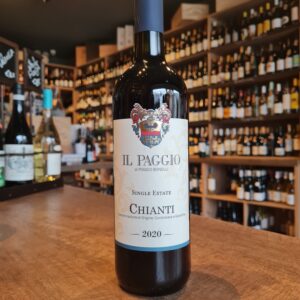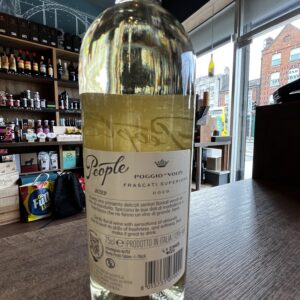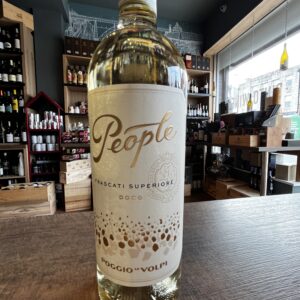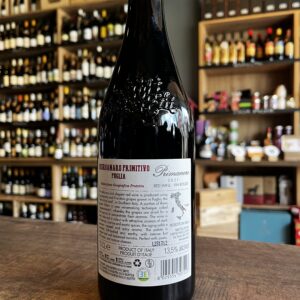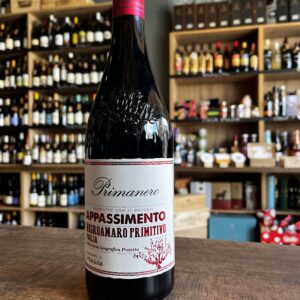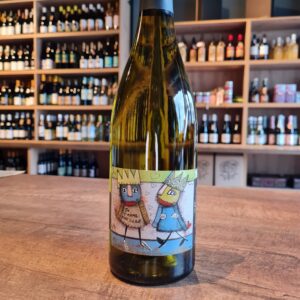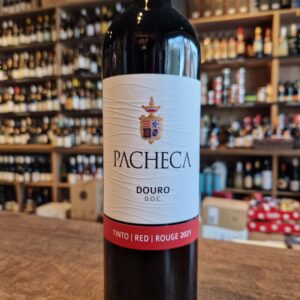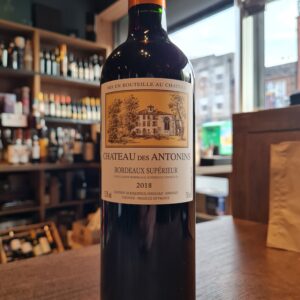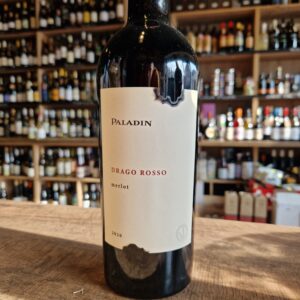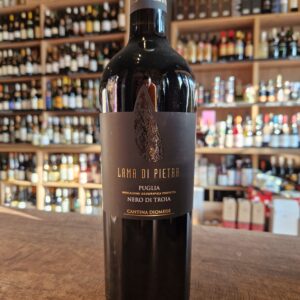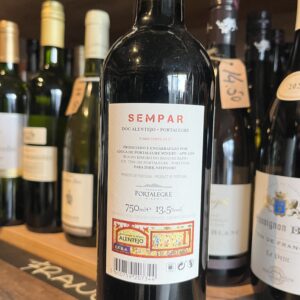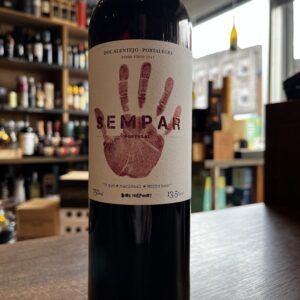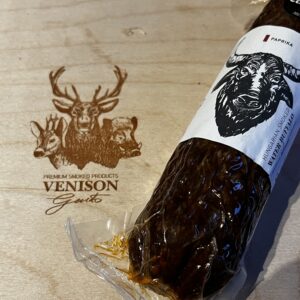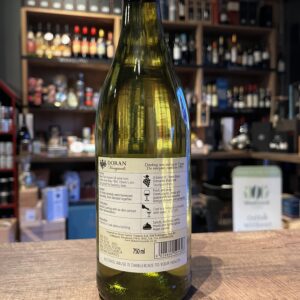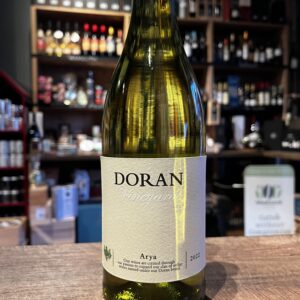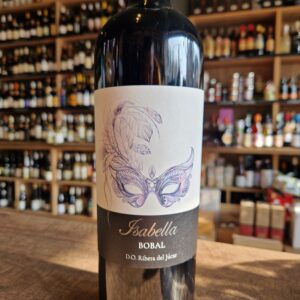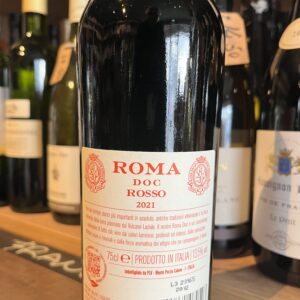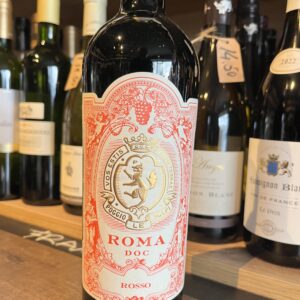-
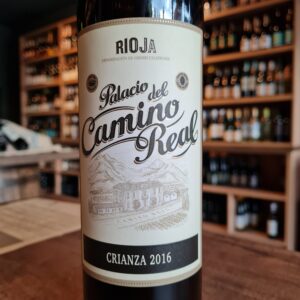 Palacio del Camino Real winery is located in the Najerilla Valley in Rioja. Isolated by the absence of railways and therefore the big wineries, the Najerilla Valley has maintained a tradition of small vineyards, consistently producing fruit of extraordinary freshness and quality. Palacio del Camino Real Crianza is a return to the essence of Rioja wines from the beginning of the 20th century in which Garnacha was the protagonist and a small percentage of white grapes could also be found. They are fresh, elegant, round and friendly wines. Palacio del Camino Real Crianza, is a red wine with an attractive ruby red color that impresses with its complex nose in which the nuances of its aging are perfectly integrated with the freshness and intensity of its chosen grapes. In the mouth it is a wine, it is a fresh, friendly, balanced wine with a long aftertaste.
Palacio del Camino Real winery is located in the Najerilla Valley in Rioja. Isolated by the absence of railways and therefore the big wineries, the Najerilla Valley has maintained a tradition of small vineyards, consistently producing fruit of extraordinary freshness and quality. Palacio del Camino Real Crianza is a return to the essence of Rioja wines from the beginning of the 20th century in which Garnacha was the protagonist and a small percentage of white grapes could also be found. They are fresh, elegant, round and friendly wines. Palacio del Camino Real Crianza, is a red wine with an attractive ruby red color that impresses with its complex nose in which the nuances of its aging are perfectly integrated with the freshness and intensity of its chosen grapes. In the mouth it is a wine, it is a fresh, friendly, balanced wine with a long aftertaste. -
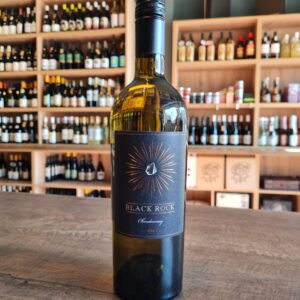 Black Rock is part of the Bronco Wine Company, which was formed in 1973 by Fred, Joseph and John Franzia. Since the start, they have been clear that the goal is to make wines for consumption, rather than for storage. At the same time, the quality must be as high as possible, at the lowest possible price. The name Bronco is a merger of brother and cousin after the brothers Fred and Joseph and their cousin John. Attractive tones of tropical fruit and a slightly spicy vanilla tone. Elegant and medium-bodied, with a nice balance and long aftertaste. Serve around 12 -14 ° C with chicken satay, or other dishes on white meat, a spicy stir-fry with noodles, fish or salad. Enjoy
Black Rock is part of the Bronco Wine Company, which was formed in 1973 by Fred, Joseph and John Franzia. Since the start, they have been clear that the goal is to make wines for consumption, rather than for storage. At the same time, the quality must be as high as possible, at the lowest possible price. The name Bronco is a merger of brother and cousin after the brothers Fred and Joseph and their cousin John. Attractive tones of tropical fruit and a slightly spicy vanilla tone. Elegant and medium-bodied, with a nice balance and long aftertaste. Serve around 12 -14 ° C with chicken satay, or other dishes on white meat, a spicy stir-fry with noodles, fish or salad. Enjoy -
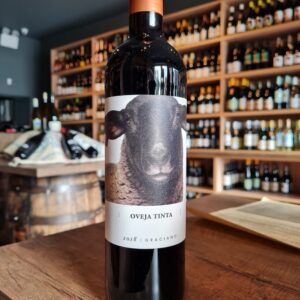 Graciano is one of Spain’s best kept wine secrets - a red grape with thick skins that is a tricky one to grow, which means there’s precious little of it about, even in the vineyards of the Rioja, where it is one of the traditional ingredients in the wine of the same name. This Biio-Organic wine has ruby red color with violet rims. On the nose aromas of wild flowers and ripe fruit, strawberry and blackberries. On the palate it is fresh and fruity, with a good level of acidity and moderate tannins.
Graciano is one of Spain’s best kept wine secrets - a red grape with thick skins that is a tricky one to grow, which means there’s precious little of it about, even in the vineyards of the Rioja, where it is one of the traditional ingredients in the wine of the same name. This Biio-Organic wine has ruby red color with violet rims. On the nose aromas of wild flowers and ripe fruit, strawberry and blackberries. On the palate it is fresh and fruity, with a good level of acidity and moderate tannins. -
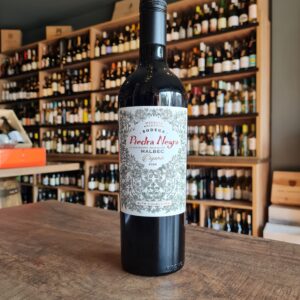 François Lurton vineyards are situated in the highlands (1,100 m) and semi-desert (poor alluvial gravels reminiscent of those of Pessac-Léognan), in the plains at the foot of the mountain range of the Andes: the Uco Valley. Thanks to his experience, acquired all over the world, he practices an environmentally friendly viticulture and produces extraordinary wines here that have a unique personality that combines freshness and concentration. Thanks to the climatic conditions of this high altitude desert and very draining and not very fertile alluvial gravel soils, the wines of the Uco Valley, and especially those of Los Chacayes, are quite unique and François Lurton vision was a success. This Malbec has a an outstanding quality/price ratio and it is definitely a contender not only for those summer barbecues but also for those cold winter nights. Pair it with Carpaccio, Paella, Iberian ham, red pepper stuffed with cheese and Hummus.
François Lurton vineyards are situated in the highlands (1,100 m) and semi-desert (poor alluvial gravels reminiscent of those of Pessac-Léognan), in the plains at the foot of the mountain range of the Andes: the Uco Valley. Thanks to his experience, acquired all over the world, he practices an environmentally friendly viticulture and produces extraordinary wines here that have a unique personality that combines freshness and concentration. Thanks to the climatic conditions of this high altitude desert and very draining and not very fertile alluvial gravel soils, the wines of the Uco Valley, and especially those of Los Chacayes, are quite unique and François Lurton vision was a success. This Malbec has a an outstanding quality/price ratio and it is definitely a contender not only for those summer barbecues but also for those cold winter nights. Pair it with Carpaccio, Paella, Iberian ham, red pepper stuffed with cheese and Hummus. -
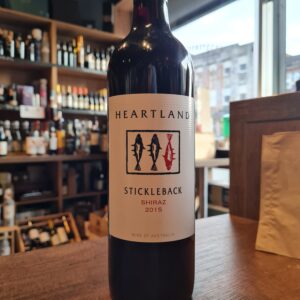 The first Glaetzers settled in the Barossa Valley in 1888 after emigrating from Brandenburg, Germany. The family left Germany on board the Nord-Deutscher Lloyd steamer “Habsburg” and took seven weeks to reach their final destination of Port Adelaide. From here they settled in a country town called Nuriootpa in the Barossa Valley where they started their new life in Australia. The family were some of the earliest recorded viticulturalists in the Barossa Valley and Clare Valley. Barossa Vintners was the first of its kind to conceive as a state-of-the-art winemaking facility with the capacity to make wines, for a core group of top end producers whose fame and demand had grown beyond their winemaking capacities. Completed in 1995, Barossa Vintners has been developed make wines in the most natural possible way. The natural slope of the land allows the winery to be gravity fed and avoid harsh pumping of the grapes and juice. The solar panels allow them to minimize carbon footprint and keep the power bills down. Ben Glaetzer makes wines for his family brand plus Mitolo in McLaren Vale and the Heartland wines from Langhorne Creek. Stickleback is Heartland's entry-level red. Perfect for an evening in front of the chimney , Party , Picknick or a barbecue. Pair it with hearty dishes , spicy food
The first Glaetzers settled in the Barossa Valley in 1888 after emigrating from Brandenburg, Germany. The family left Germany on board the Nord-Deutscher Lloyd steamer “Habsburg” and took seven weeks to reach their final destination of Port Adelaide. From here they settled in a country town called Nuriootpa in the Barossa Valley where they started their new life in Australia. The family were some of the earliest recorded viticulturalists in the Barossa Valley and Clare Valley. Barossa Vintners was the first of its kind to conceive as a state-of-the-art winemaking facility with the capacity to make wines, for a core group of top end producers whose fame and demand had grown beyond their winemaking capacities. Completed in 1995, Barossa Vintners has been developed make wines in the most natural possible way. The natural slope of the land allows the winery to be gravity fed and avoid harsh pumping of the grapes and juice. The solar panels allow them to minimize carbon footprint and keep the power bills down. Ben Glaetzer makes wines for his family brand plus Mitolo in McLaren Vale and the Heartland wines from Langhorne Creek. Stickleback is Heartland's entry-level red. Perfect for an evening in front of the chimney , Party , Picknick or a barbecue. Pair it with hearty dishes , spicy food -
Out of stock
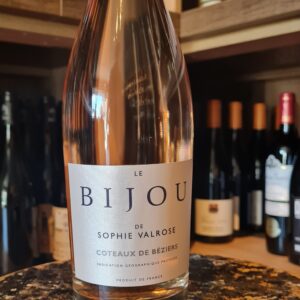 Le Bijou de Sophie Valrose is named after a lady who worked in the Languedoc vineyards during the late 19th century and became something of a local hero. At the time, it was largely women who worked in the vineyards; pruning and harvesting the vines. Sadly these women were often mistreated, overworked and underpaid. Sophie fought for women’s rights and drastically improved the conditions for her fellow female workers in the vineyard in which she worked. Bijou is a tribute to her memory and we share her story on the back of every bottle sold. The grapes are sourced from low-yielding old vines on the sloping hillsides of various vineyards in the Languedoc-Roussillon region of southern France. The areas are made up of old volcanic soils composed of 70% schist, which helps create high-quality grapes with great structure and freshness.Bijou’s flagship wine, a beautiful pale salmon coloured rosé. Elegantly fragrant, with aromas of wild strawberries, citrus and delicate floral notes. Round and creamy on the palate, with ripe red berry flavours and a soft minerality. Elegant and balanced with refreshing acidity and a silky smooth finish. The perfect accompaniment to canapés, white meats, fish and salads.
Le Bijou de Sophie Valrose is named after a lady who worked in the Languedoc vineyards during the late 19th century and became something of a local hero. At the time, it was largely women who worked in the vineyards; pruning and harvesting the vines. Sadly these women were often mistreated, overworked and underpaid. Sophie fought for women’s rights and drastically improved the conditions for her fellow female workers in the vineyard in which she worked. Bijou is a tribute to her memory and we share her story on the back of every bottle sold. The grapes are sourced from low-yielding old vines on the sloping hillsides of various vineyards in the Languedoc-Roussillon region of southern France. The areas are made up of old volcanic soils composed of 70% schist, which helps create high-quality grapes with great structure and freshness.Bijou’s flagship wine, a beautiful pale salmon coloured rosé. Elegantly fragrant, with aromas of wild strawberries, citrus and delicate floral notes. Round and creamy on the palate, with ripe red berry flavours and a soft minerality. Elegant and balanced with refreshing acidity and a silky smooth finish. The perfect accompaniment to canapés, white meats, fish and salads. -
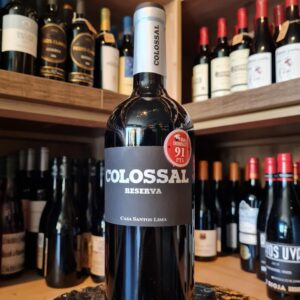 This blend of Touriga Nacional, Syrah, Tinta Roriz, and Alicante Bouschet lives up to its name. With an intense rubi colour, this wine presents itself with a great concentration in the nose. Extremely rich aroma with predominance of red ripe fruits and some floral notes, well integrated with notes of spices coming from the ageing in French and American oak barrels. In the mouth it shows great complexity with notes of plums and blackberries. The finish is rich and elegant. Excellent wine for hearty spiced meals with red grilled or roast meat, lamb and game dishes. Enjoy!
This blend of Touriga Nacional, Syrah, Tinta Roriz, and Alicante Bouschet lives up to its name. With an intense rubi colour, this wine presents itself with a great concentration in the nose. Extremely rich aroma with predominance of red ripe fruits and some floral notes, well integrated with notes of spices coming from the ageing in French and American oak barrels. In the mouth it shows great complexity with notes of plums and blackberries. The finish is rich and elegant. Excellent wine for hearty spiced meals with red grilled or roast meat, lamb and game dishes. Enjoy! -
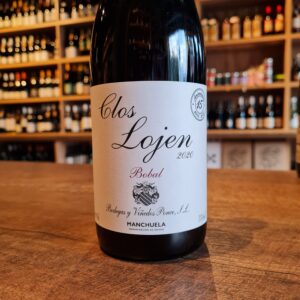 Manchuela is the spiritual home of the Bobal grape. Clos Lojen made by Bodega y Viñedos Ponce is a biodynamic and pure 100% Bobal from limestone soils, fermented in big oak casks. Bobal is the 2nd most planted red variety in Spain yet so little of it reaches the heights of which it’s undoubtedly capable. With a naturally deep colour, high levels of tannins, high acidity and an ability to be exciting as either a blending partner or a mono-varietal wine, momentum needs to be gained with Bobal, till then we seek winemakers that do exciting things and produce wines that are fun to drink. As per Juan Antonio Ponce own words “I want my wines to be bought by any ordinary person. We must be able to reach consumers in a straight-forward manner otherwise beer will cannibalize our markets.”
Manchuela is the spiritual home of the Bobal grape. Clos Lojen made by Bodega y Viñedos Ponce is a biodynamic and pure 100% Bobal from limestone soils, fermented in big oak casks. Bobal is the 2nd most planted red variety in Spain yet so little of it reaches the heights of which it’s undoubtedly capable. With a naturally deep colour, high levels of tannins, high acidity and an ability to be exciting as either a blending partner or a mono-varietal wine, momentum needs to be gained with Bobal, till then we seek winemakers that do exciting things and produce wines that are fun to drink. As per Juan Antonio Ponce own words “I want my wines to be bought by any ordinary person. We must be able to reach consumers in a straight-forward manner otherwise beer will cannibalize our markets.” -
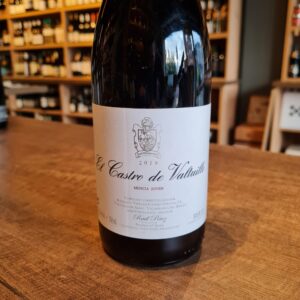 The Castro Ventosa estate was founded by the Perez family in 1752 and has been in the family ever since. They own 75 hectares of Mencía vines in Bierzo, making them the biggest owners of this varietal within the D.O Bierzo. For this wine, younger vines are used from 17 parcels across the Valtuille de Abajo village zone. Vines range from 20-40 years and viticulture is conventional, everything is done by hand and vines are not irrigated. Pair it with hard cheese, pasta, red meat, roasted vegetables.
The Castro Ventosa estate was founded by the Perez family in 1752 and has been in the family ever since. They own 75 hectares of Mencía vines in Bierzo, making them the biggest owners of this varietal within the D.O Bierzo. For this wine, younger vines are used from 17 parcels across the Valtuille de Abajo village zone. Vines range from 20-40 years and viticulture is conventional, everything is done by hand and vines are not irrigated. Pair it with hard cheese, pasta, red meat, roasted vegetables. -
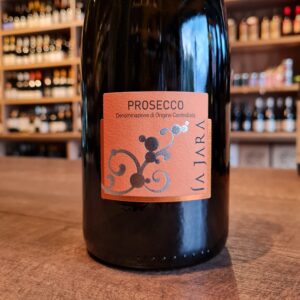 La Jara, based in the heart of Prosecco country just south of Conegliano, make a superb range of organic wines including some excellent Proseccos such as this. Being a frizzante it's got a soft sparkle and in some ways helps the fruit character stand out that bit more. With masses of fine bubbles and flavours of apple, peach, pear and ripe citrus fruits it's a very approachable style that's perhaps a bit too easy to drink. Certainly a step above a lot of other Proseccos. It's freshness makes it a great 'anytime' fizz. It's also really good alongside nibbles like olives, or tortilla chips and dips.
La Jara, based in the heart of Prosecco country just south of Conegliano, make a superb range of organic wines including some excellent Proseccos such as this. Being a frizzante it's got a soft sparkle and in some ways helps the fruit character stand out that bit more. With masses of fine bubbles and flavours of apple, peach, pear and ripe citrus fruits it's a very approachable style that's perhaps a bit too easy to drink. Certainly a step above a lot of other Proseccos. It's freshness makes it a great 'anytime' fizz. It's also really good alongside nibbles like olives, or tortilla chips and dips. -
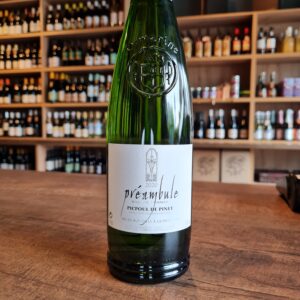 Picpoul de Pinet is a vivid illustration of just how dramatically white wine from the south of France has improved over recent years. Quite simply, the grape variety is Picpoul, or Piquepoul, which is grown around the village of Pinet, and other nearby villages, Florensac, Pomerols. Castelnau de Guers, Mèze and Montagnac. The vineyards form a surprising oasis of white wine in a sea of red wine. The terroir, or soil, explains the reason for this unexpected oasis of white wine. Quite simply the soil is too generous for red wine. It is mainly limestone, which suits white wine, with some clay, sand and appropriately a scattering of fossilised oyster shells. The climate is very much influenced by the sea, with a cooling effect during the nights of the hot summer months, and the vines benefit from maritime breezes. In somes cases it is fair to compare it to Muscadet. Neither packs a punch of flavour, but they provide brilliant accompaniments to the local seafood, and when finely crafted, have deliciously subtle flavours. The cooperative at Pinet, with its brand name L’Ormarine, and striking logo conveying the blue sea, green vines and yellow sun, are amongst the pacesetters of the appellation.
Picpoul de Pinet is a vivid illustration of just how dramatically white wine from the south of France has improved over recent years. Quite simply, the grape variety is Picpoul, or Piquepoul, which is grown around the village of Pinet, and other nearby villages, Florensac, Pomerols. Castelnau de Guers, Mèze and Montagnac. The vineyards form a surprising oasis of white wine in a sea of red wine. The terroir, or soil, explains the reason for this unexpected oasis of white wine. Quite simply the soil is too generous for red wine. It is mainly limestone, which suits white wine, with some clay, sand and appropriately a scattering of fossilised oyster shells. The climate is very much influenced by the sea, with a cooling effect during the nights of the hot summer months, and the vines benefit from maritime breezes. In somes cases it is fair to compare it to Muscadet. Neither packs a punch of flavour, but they provide brilliant accompaniments to the local seafood, and when finely crafted, have deliciously subtle flavours. The cooperative at Pinet, with its brand name L’Ormarine, and striking logo conveying the blue sea, green vines and yellow sun, are amongst the pacesetters of the appellation. -
Out of stock
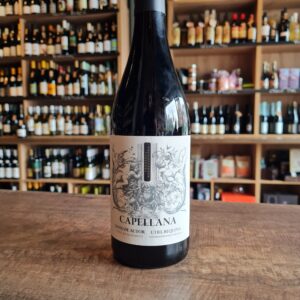 This complex and medium to full-bodied wine is made from Cabernet Sauvignon and Tempranillo grapes. It matured for 7 months in American oak barrels to its full taste. The Cabernet brings strength and abundance here, Tempranillo provides fruit and structure. The result is a wine with character and personality. Cherry juice-colored to brick-red in the glass. Overwhelming scent of cherries, plums and wild berries; the same fruits pickled in rum, all nobly underlaid with fine toasted notes from the wooden barrel. The oak wood is noticeable, but does not dominate the wine. In the mouth the wine is well structured, full and with little surprising tannins. Ideal to accompany grilled meats and different types of stews.
This complex and medium to full-bodied wine is made from Cabernet Sauvignon and Tempranillo grapes. It matured for 7 months in American oak barrels to its full taste. The Cabernet brings strength and abundance here, Tempranillo provides fruit and structure. The result is a wine with character and personality. Cherry juice-colored to brick-red in the glass. Overwhelming scent of cherries, plums and wild berries; the same fruits pickled in rum, all nobly underlaid with fine toasted notes from the wooden barrel. The oak wood is noticeable, but does not dominate the wine. In the mouth the wine is well structured, full and with little surprising tannins. Ideal to accompany grilled meats and different types of stews. -
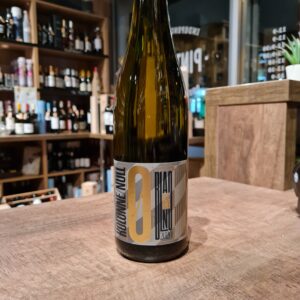 With admirable precision and innovative ideas, the family-run winery Pauly, now in its 3rd generation, succeeds in producing stylish wines with an outstanding character of their own. The winery is not only known for its famous steep slope on the Niederberg-Helden on the Mosel River, but also for the unique slate minerality that gives the wines an elegant, fresh style. The alcohol-free Riesling from Kolonne Null is perfect for all wine enthusiasts who like as little residual sweetness in their wine as possible. Best enjoyed very well chilled at 5 - 7°C. It is perfect as an accompaniment to stir-fried vegetables with fish, omelette with salmon and fennel or vegetable salad with beetroot.
With admirable precision and innovative ideas, the family-run winery Pauly, now in its 3rd generation, succeeds in producing stylish wines with an outstanding character of their own. The winery is not only known for its famous steep slope on the Niederberg-Helden on the Mosel River, but also for the unique slate minerality that gives the wines an elegant, fresh style. The alcohol-free Riesling from Kolonne Null is perfect for all wine enthusiasts who like as little residual sweetness in their wine as possible. Best enjoyed very well chilled at 5 - 7°C. It is perfect as an accompaniment to stir-fried vegetables with fish, omelette with salmon and fennel or vegetable salad with beetroot. -
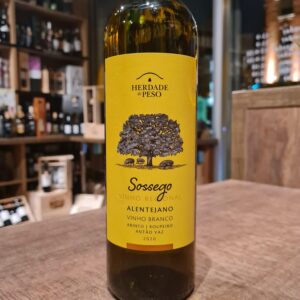 Sogrape Vinhos has been investing in the classic winegrowing regions of Portugal since it was set up in 1942. With a strong presence in the regions of Dão, Douro and (MInho) Vinhos Verdes, their entrance into the Alentejo — the winegrowing region with the highest growth rate in the country — was a natural step. Herdade do Peso Sossego Branco offers the authenticity and immediate passion of Alentejo flavors in a refreshing and aromatic wine. Herdade do Peso is the brand that revitalizes the deepest essence of the region, brought to the surface by the science and know-how of Sogrape Vinhos. The result is the production of exuberant and attractive wines, whose flavors, aromas and colors remind us of life at its best, just like the region where they are born. Sossego White is a refreshing wine that is full of flavour, perfect when served on its own or as na aperitif. It is an excellent accompaniment to various fish dishes, white meats and a variety of salads.
Sogrape Vinhos has been investing in the classic winegrowing regions of Portugal since it was set up in 1942. With a strong presence in the regions of Dão, Douro and (MInho) Vinhos Verdes, their entrance into the Alentejo — the winegrowing region with the highest growth rate in the country — was a natural step. Herdade do Peso Sossego Branco offers the authenticity and immediate passion of Alentejo flavors in a refreshing and aromatic wine. Herdade do Peso is the brand that revitalizes the deepest essence of the region, brought to the surface by the science and know-how of Sogrape Vinhos. The result is the production of exuberant and attractive wines, whose flavors, aromas and colors remind us of life at its best, just like the region where they are born. Sossego White is a refreshing wine that is full of flavour, perfect when served on its own or as na aperitif. It is an excellent accompaniment to various fish dishes, white meats and a variety of salads. -
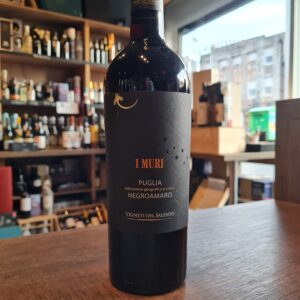 Great value wine from Puglia. This is Farnese’s venture in Puglia. The wines are made at two wineries in the province of Taranto on the western flank of Salento. The style of the wines - fresh whites, soft and generous reds - will be familiar to those who buy their other wines, as winemaker Filippo Baccalaro is the driving force behind this label. Filippo, a native of Piemonte, has been working in Puglia for almost two decades. He was attracted by the rich, ripe flavours of the fruit, and has the potential to capture these flavours with minimal use of technology and a lot of know-how. The vineyards are mostly situated in the communes of Manduria and Sava and are owned by growers with whom Filippo has been working for many years. Production is lower than its potential, which ensures the best quality grapes are selected. The red soils are calcerous clay and rich in iron, minerals and nutrients. 80% of the grapes come from old bush vines and the rest from trained vines that are at least 20 years old. Spring was colder than usual, and this slowed down budbreak and flowering. May and June followed with above average rainfall. Despite this, the Mistral and the north wind persisted for more than 30 days and this allowed vines to keep healthy during the ripening phase delivering extraordinary quality but with 20% lower yields. Enjoy with Pastas, cheeses, Chicken dishes and some not too rich red meats
Great value wine from Puglia. This is Farnese’s venture in Puglia. The wines are made at two wineries in the province of Taranto on the western flank of Salento. The style of the wines - fresh whites, soft and generous reds - will be familiar to those who buy their other wines, as winemaker Filippo Baccalaro is the driving force behind this label. Filippo, a native of Piemonte, has been working in Puglia for almost two decades. He was attracted by the rich, ripe flavours of the fruit, and has the potential to capture these flavours with minimal use of technology and a lot of know-how. The vineyards are mostly situated in the communes of Manduria and Sava and are owned by growers with whom Filippo has been working for many years. Production is lower than its potential, which ensures the best quality grapes are selected. The red soils are calcerous clay and rich in iron, minerals and nutrients. 80% of the grapes come from old bush vines and the rest from trained vines that are at least 20 years old. Spring was colder than usual, and this slowed down budbreak and flowering. May and June followed with above average rainfall. Despite this, the Mistral and the north wind persisted for more than 30 days and this allowed vines to keep healthy during the ripening phase delivering extraordinary quality but with 20% lower yields. Enjoy with Pastas, cheeses, Chicken dishes and some not too rich red meats -
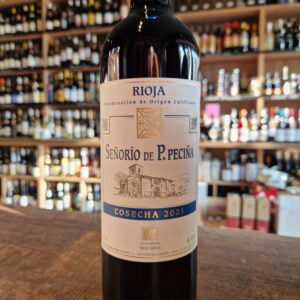 Bodegas Hermanos de Peciña is firmly planted in the old school camp. Although the estate was started only in 1992, its founder, Pedro Peciña had worked for over 20 years prior to that as the head agronomist for La Rioja Alta, learning all facets of production and especially the planting and managing of all the estate’s vineyards. The Peciña winery and vineyards are located in San Vicente, which while technically in the Rioja Alta sub-zone, is not in the vicinity of Haro where most of the other traditional Rioja houses have their cellars. Rather it is located on the northeast side of the Ebro river near the border of the Basque Alavesa zone. These vineyards - many 40 to 60 years old - are actually some of the finest in the appellation as they fall at the foothills of the Sierra Cantabria Mountains at an average of 500 meters, and offer hillside expositions as well as complex and diverse soils. Many of Peciña’s most prized vineyards are actually on north facing slopes which Pedro feels helps give the wines good freshness and delineation. Serve with aperitif, Charcuterie, Cured cheeses, Smoked foods
Bodegas Hermanos de Peciña is firmly planted in the old school camp. Although the estate was started only in 1992, its founder, Pedro Peciña had worked for over 20 years prior to that as the head agronomist for La Rioja Alta, learning all facets of production and especially the planting and managing of all the estate’s vineyards. The Peciña winery and vineyards are located in San Vicente, which while technically in the Rioja Alta sub-zone, is not in the vicinity of Haro where most of the other traditional Rioja houses have their cellars. Rather it is located on the northeast side of the Ebro river near the border of the Basque Alavesa zone. These vineyards - many 40 to 60 years old - are actually some of the finest in the appellation as they fall at the foothills of the Sierra Cantabria Mountains at an average of 500 meters, and offer hillside expositions as well as complex and diverse soils. Many of Peciña’s most prized vineyards are actually on north facing slopes which Pedro feels helps give the wines good freshness and delineation. Serve with aperitif, Charcuterie, Cured cheeses, Smoked foods -
 The Le Rime appears pale yellow with green highlights, with intense aromas of green fruit followed by zippy citrus on the nose. The palate is fresh and lively with ripe pear and juicy green apple in abundance, finishing clean and full with persistent fruit and citrus cream, particularly fetching but do not overchill and allow to open in the glass. Best consumed young and would be ideal with fresh fish and summer salads.
The Le Rime appears pale yellow with green highlights, with intense aromas of green fruit followed by zippy citrus on the nose. The palate is fresh and lively with ripe pear and juicy green apple in abundance, finishing clean and full with persistent fruit and citrus cream, particularly fetching but do not overchill and allow to open in the glass. Best consumed young and would be ideal with fresh fish and summer salads. -
Out of stock
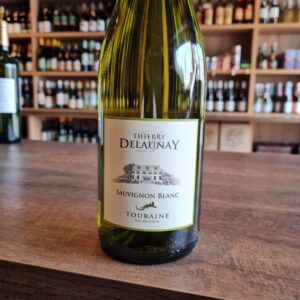 Touraine is the savvy place to look if you’re after a Sauvignon blanc which combines great value with great flavour. The Loire is Sauvignon Blanc’s homeland. So it’s no surprise that Loire native, Thierry Delaunay, is passionate about the grape. Decades of his family making wine in the region means he has the pick of the crop when it comes to choosing grapes for his wines. He looks for the best grapes from the best pockets of vines in Touraine – and the results speak for themselves. This Sauvignon is seriously refreshing, seriously citrusy, and seriously good value. You’ll find nothing finer to pair with a goat’s cheese tart. And its more restrained flavour profile makes it a perfect party wine. Santé.
Touraine is the savvy place to look if you’re after a Sauvignon blanc which combines great value with great flavour. The Loire is Sauvignon Blanc’s homeland. So it’s no surprise that Loire native, Thierry Delaunay, is passionate about the grape. Decades of his family making wine in the region means he has the pick of the crop when it comes to choosing grapes for his wines. He looks for the best grapes from the best pockets of vines in Touraine – and the results speak for themselves. This Sauvignon is seriously refreshing, seriously citrusy, and seriously good value. You’ll find nothing finer to pair with a goat’s cheese tart. And its more restrained flavour profile makes it a perfect party wine. Santé. -
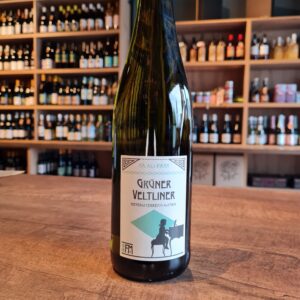 Gruner Veltliner is Austria’s most important indigenous grape and up until the 1990s it was relatively unheard of. Gruner Veltliner has many charms, one of them being the consistency of the quality and the flavour profile; it always delivers what it says on the tin. Ferdinand Mayr is a musician turned winemaker and his organic wines are singing with flavour and intensity. Whoever says Grüner Veltliner says Austria and vice versa. This version of Ferdinand Mayr is accessible and it charms you right away. Exuberant, lively nose of citrus, apple and white pepper. On the palate, the ripe fruit and spiciness create a pleasant tension with the acidity. Crispy and ripe, as if you were biting into a juicy apple. Flavor and spiciness characterize this wine. Fantastic with Japanese or Thai cuisine.
Gruner Veltliner is Austria’s most important indigenous grape and up until the 1990s it was relatively unheard of. Gruner Veltliner has many charms, one of them being the consistency of the quality and the flavour profile; it always delivers what it says on the tin. Ferdinand Mayr is a musician turned winemaker and his organic wines are singing with flavour and intensity. Whoever says Grüner Veltliner says Austria and vice versa. This version of Ferdinand Mayr is accessible and it charms you right away. Exuberant, lively nose of citrus, apple and white pepper. On the palate, the ripe fruit and spiciness create a pleasant tension with the acidity. Crispy and ripe, as if you were biting into a juicy apple. Flavor and spiciness characterize this wine. Fantastic with Japanese or Thai cuisine. -
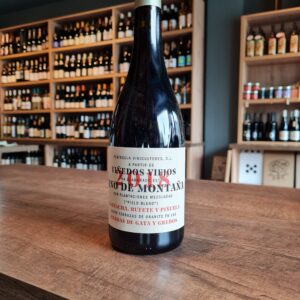 Vinos de Montaña is from a range of mountain wines on high-altitude vineyards in Sierra de Gredos and other historic growing areas in the Sistema Central, the mountain chain that divides the Iberian Peninsula in its Northern and Southern halves. Based mostly on very old Garnacha vines on granite soil, the wines are perfumed, delicate and fresh, displaying the character of their vineyard parcels and villages. This organic wine even though is from a recent created bodega/company, is from old vines revived in the mountain where wine was produced for decades. The Spanish market seemed to picked up on it, as it is becoming increasingly popular with the new enthusiastic wine drinkers generation. Recommended pairing with grilled vegetables, sausages, roasted meats, small game, cured cheeses.
Vinos de Montaña is from a range of mountain wines on high-altitude vineyards in Sierra de Gredos and other historic growing areas in the Sistema Central, the mountain chain that divides the Iberian Peninsula in its Northern and Southern halves. Based mostly on very old Garnacha vines on granite soil, the wines are perfumed, delicate and fresh, displaying the character of their vineyard parcels and villages. This organic wine even though is from a recent created bodega/company, is from old vines revived in the mountain where wine was produced for decades. The Spanish market seemed to picked up on it, as it is becoming increasingly popular with the new enthusiastic wine drinkers generation. Recommended pairing with grilled vegetables, sausages, roasted meats, small game, cured cheeses. -
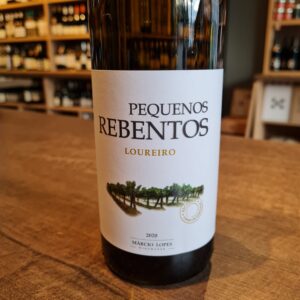 Márcio Lopes studied as an engineer, but cut his winemaking teeth working for two years with Vinho Verde master Anselmo Mendes in Melgaço. He then travelled to Australia where he made wine in Rutherglen and Tasmania, another cool climate region. He returned to Portugal in 2010 to start his own projects, including Pequenos Rebentos in Vinho Verde. He initially started working with Alvarinho and Trajadura (known as Albariño and Treixadura in Spain) from the sub-regions of Monção and Melgaço. These areas have a very particular microclimate, with slightly less Atlantic influence than the rest of the region - winters are cold with moderate rainfall and summers are hot and dry. During 2016 he also started to grow and vinify local varietals Loureiro. He now farms 5ha of vineyards, planted on granite, as well as buying some grapes from selected growers who also work in the same sustainable way and without herbicides. His winemaking is low intervention, he ferments using natural yeasts, and like many of our producers he believes that if the fruit is good enough he will make quality wines with balance that reflect his terroir. This seems to be working - his wines are distinctively fresh and vibrant, showing bright and clear typical variety aromas.
Márcio Lopes studied as an engineer, but cut his winemaking teeth working for two years with Vinho Verde master Anselmo Mendes in Melgaço. He then travelled to Australia where he made wine in Rutherglen and Tasmania, another cool climate region. He returned to Portugal in 2010 to start his own projects, including Pequenos Rebentos in Vinho Verde. He initially started working with Alvarinho and Trajadura (known as Albariño and Treixadura in Spain) from the sub-regions of Monção and Melgaço. These areas have a very particular microclimate, with slightly less Atlantic influence than the rest of the region - winters are cold with moderate rainfall and summers are hot and dry. During 2016 he also started to grow and vinify local varietals Loureiro. He now farms 5ha of vineyards, planted on granite, as well as buying some grapes from selected growers who also work in the same sustainable way and without herbicides. His winemaking is low intervention, he ferments using natural yeasts, and like many of our producers he believes that if the fruit is good enough he will make quality wines with balance that reflect his terroir. This seems to be working - his wines are distinctively fresh and vibrant, showing bright and clear typical variety aromas. -
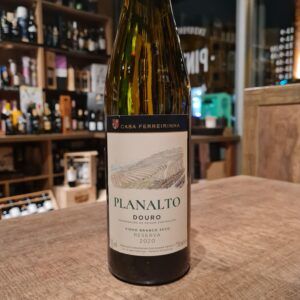 Planalto is one of the biggest references of white wine in the Douro Demarcated Region, fruit of the in-depth studies carried out over the years, the careful choice of the grape varieties that compose it and the use of the best winemaking technology in its production. This white blend comes from high-altitude vineyards above the river Douro. The soil in the Douro Valley is schistous; a slate-like metamorphic rock that fractures vertically - allowing vine roots to dig deep to access water and nutrients to sustain them through the hot Douro summers. The poor quality of the soil forces the grapes to produce low yields of grapes with a great concentration of flavour. The grapes were harvested by hand and were selected for their balance between flavour intensity and freshness. Ideal to accompany fish, seafood and white meat dishes.
Planalto is one of the biggest references of white wine in the Douro Demarcated Region, fruit of the in-depth studies carried out over the years, the careful choice of the grape varieties that compose it and the use of the best winemaking technology in its production. This white blend comes from high-altitude vineyards above the river Douro. The soil in the Douro Valley is schistous; a slate-like metamorphic rock that fractures vertically - allowing vine roots to dig deep to access water and nutrients to sustain them through the hot Douro summers. The poor quality of the soil forces the grapes to produce low yields of grapes with a great concentration of flavour. The grapes were harvested by hand and were selected for their balance between flavour intensity and freshness. Ideal to accompany fish, seafood and white meat dishes. -
Out of stock
 Villa Raiano was founded in 1996 in the old factories of the Basso family's oil mill, owner of the company in the Raiano hamlet of the municipality of Serino (AV). Built in 2009, the is structure perfectly integrated into the surrounding environment, surrounded by vineyards and woods. On top of it a panoramic terrace overlooking a wonderful valley carved by the river Sabato which descends proudly from Monte Terminio. This delicious summer wine from the extreme south of Italy makes you long for Italy. A delicious, light-footed summer wine with a sultry taste of honey, flowers and fresh notes of citrus fruits. The Falanghina grape is still relatively unknown in the Ireland, but in Italy a guarantee for a smooth summer wine that can be drunk on it's own or over lunch.The artisan winemakers of Villa Raiano are behind this fantastic Virgo Falanghina, you can expect high quality. In addition, all grapes are picked by hand by Gabrizia and her brothers. And you can taste it! A delicious traditional wine that is made with the utmost care in a sustainable way.
Villa Raiano was founded in 1996 in the old factories of the Basso family's oil mill, owner of the company in the Raiano hamlet of the municipality of Serino (AV). Built in 2009, the is structure perfectly integrated into the surrounding environment, surrounded by vineyards and woods. On top of it a panoramic terrace overlooking a wonderful valley carved by the river Sabato which descends proudly from Monte Terminio. This delicious summer wine from the extreme south of Italy makes you long for Italy. A delicious, light-footed summer wine with a sultry taste of honey, flowers and fresh notes of citrus fruits. The Falanghina grape is still relatively unknown in the Ireland, but in Italy a guarantee for a smooth summer wine that can be drunk on it's own or over lunch.The artisan winemakers of Villa Raiano are behind this fantastic Virgo Falanghina, you can expect high quality. In addition, all grapes are picked by hand by Gabrizia and her brothers. And you can taste it! A delicious traditional wine that is made with the utmost care in a sustainable way. -
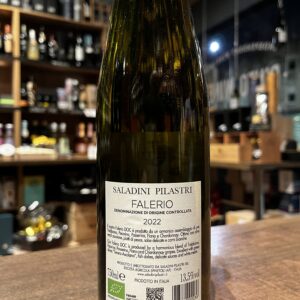
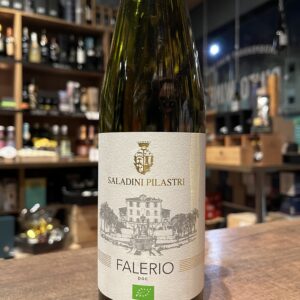 Saladini Pilastri is located in Spinetoli, in the Marche region of Italy . The history of the Counts Saladini Pilastri, a noble family from Ascoli Piceno, dates back to the early 1000s, but it is only for around 300 years that the family has been dedicated to wine production. Its 320 hectare wine estate is located in the heart of the Rosso Piceno production area. From the 1970s, new vines were planted; The current winery was built next to the splendid 15th century country house “Vigna Palazzi”, which originally served as a production site, so that all production could be kept in one place. The vineyard has been certified in organic farming since 1994. The climate here is Mediterranean, with hot, dry summers tempered by the maritime influence of the Adriatic Sea only 8km away from the vineyards. All the farming is organic and the winery is equipped with all the latest wine-making mod cons, helping speeding up the complex time of production and maintain quality. In true Italian style-Great wine with great food it helps that at the heart of the estate is a plush mansion house with a sweet swimming pool!. True quality of life. If I wasn't Portuguese, Italy would be where I would retire. Food-friendly as they come, its easy-going qualities match well with antipasti or even creamy pasta dishes but especially fish orientated dishes. Goditi il Vino!
Saladini Pilastri is located in Spinetoli, in the Marche region of Italy . The history of the Counts Saladini Pilastri, a noble family from Ascoli Piceno, dates back to the early 1000s, but it is only for around 300 years that the family has been dedicated to wine production. Its 320 hectare wine estate is located in the heart of the Rosso Piceno production area. From the 1970s, new vines were planted; The current winery was built next to the splendid 15th century country house “Vigna Palazzi”, which originally served as a production site, so that all production could be kept in one place. The vineyard has been certified in organic farming since 1994. The climate here is Mediterranean, with hot, dry summers tempered by the maritime influence of the Adriatic Sea only 8km away from the vineyards. All the farming is organic and the winery is equipped with all the latest wine-making mod cons, helping speeding up the complex time of production and maintain quality. In true Italian style-Great wine with great food it helps that at the heart of the estate is a plush mansion house with a sweet swimming pool!. True quality of life. If I wasn't Portuguese, Italy would be where I would retire. Food-friendly as they come, its easy-going qualities match well with antipasti or even creamy pasta dishes but especially fish orientated dishes. Goditi il Vino! -
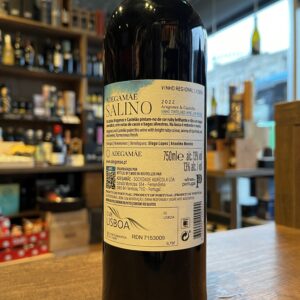
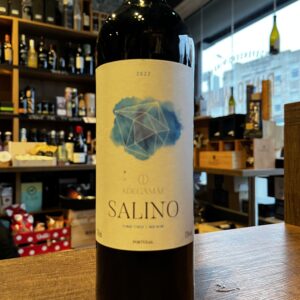 Salino is from north from Lisbon (Torres Vedras) and just a step away from the ocean, AdegaMãe brings out the best of a terroir strongly influenced by the prevailing sea breezes, standing out for its Atlantic-inspired wines, brimming with character, freshness and minerality. The winery was built by the Alves family, founder of Riberalves Group, AdegaMãe is born as a tribute from the men to the family’s matriarch, Manuela Alves. On this particular project, 2 star winemakers were asked to do an everydays wine that brings quality and immediate expression to the palate. Pair it with Charcuterie of all sorts, red meats and stews
Salino is from north from Lisbon (Torres Vedras) and just a step away from the ocean, AdegaMãe brings out the best of a terroir strongly influenced by the prevailing sea breezes, standing out for its Atlantic-inspired wines, brimming with character, freshness and minerality. The winery was built by the Alves family, founder of Riberalves Group, AdegaMãe is born as a tribute from the men to the family’s matriarch, Manuela Alves. On this particular project, 2 star winemakers were asked to do an everydays wine that brings quality and immediate expression to the palate. Pair it with Charcuterie of all sorts, red meats and stews -
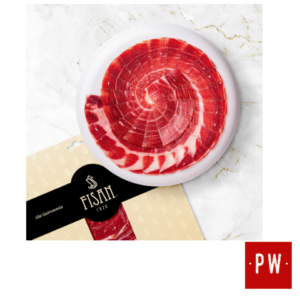 One of FISAN’s most prized products in a practical format to delight your palate with the most extraordinary nuances of 100% Iberico Bellota Ham Alta Gastronomia at any time and place. Its secret: the selection from the earliest stage of the best pure Iberico breed pigs, patience and curing in our natural cellars in Guijuelo, which leads to the best Pata Negra Ham you will ever remember. Only the most exceptional pieces qualify as Alta Gastronomia.
One of FISAN’s most prized products in a practical format to delight your palate with the most extraordinary nuances of 100% Iberico Bellota Ham Alta Gastronomia at any time and place. Its secret: the selection from the earliest stage of the best pure Iberico breed pigs, patience and curing in our natural cellars in Guijuelo, which leads to the best Pata Negra Ham you will ever remember. Only the most exceptional pieces qualify as Alta Gastronomia. -
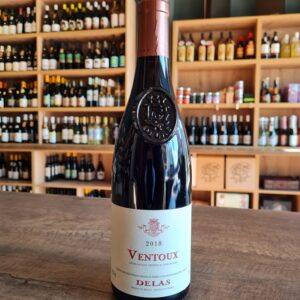 Delas Frères Ventoux is a red wine blend made with grapes from the south eastern region of the Rhône winegrowing region of France. Delas Frères are one of the most prestigious Rhone wine producers and make superb wines, from a wide selection of appellations, in both the northern and southern Rhône including Hermitage, Crozes-Hermitage, Châteauneuf-du-Pape, Côte Rôtie, Condrieu and Côtes-du-Rhône. The company was founded in 1835 when Charles Audibert and Philippe Delas bought Maisons Junique, a 40-year-old winery which they renamed Audibert & Delas. Philippe Delas had two sons, Henri and Florentin. The latter married the daughter of Charles Audibert, further strengthening the bond between the two families. In 1924, the brothers succeeded to the founders and changed the name of the house to Delas Frères. The company grew and in 1981 relocated to the its current premises in Saint Jean de Muzols, a small village located two kilometers north of Tournon in the Saint Joseph appellation. In 1993 Delas Frères became part of the Champagne Louis Roederer group. Delas Frères Ventoux is a blend of Grenache and Syrah grapes which are sourced from the communes of Mazan and Goult from vineyards which stretch out along the left bank of the Rhône river, around the limestone outcrop of the Mount Ventoux. The Grenache grapes are fermented in stainless steel vats with a daily pumping over to allow gentle extraction of the phenolic components. The Syrah is sometimes left on the stems in order to fully express its characteristic fruit aromas. The two components are blended before they wines is matured for 6 to 8 months in Delas’ air-conditioned winery before bottling.
Delas Frères Ventoux is a red wine blend made with grapes from the south eastern region of the Rhône winegrowing region of France. Delas Frères are one of the most prestigious Rhone wine producers and make superb wines, from a wide selection of appellations, in both the northern and southern Rhône including Hermitage, Crozes-Hermitage, Châteauneuf-du-Pape, Côte Rôtie, Condrieu and Côtes-du-Rhône. The company was founded in 1835 when Charles Audibert and Philippe Delas bought Maisons Junique, a 40-year-old winery which they renamed Audibert & Delas. Philippe Delas had two sons, Henri and Florentin. The latter married the daughter of Charles Audibert, further strengthening the bond between the two families. In 1924, the brothers succeeded to the founders and changed the name of the house to Delas Frères. The company grew and in 1981 relocated to the its current premises in Saint Jean de Muzols, a small village located two kilometers north of Tournon in the Saint Joseph appellation. In 1993 Delas Frères became part of the Champagne Louis Roederer group. Delas Frères Ventoux is a blend of Grenache and Syrah grapes which are sourced from the communes of Mazan and Goult from vineyards which stretch out along the left bank of the Rhône river, around the limestone outcrop of the Mount Ventoux. The Grenache grapes are fermented in stainless steel vats with a daily pumping over to allow gentle extraction of the phenolic components. The Syrah is sometimes left on the stems in order to fully express its characteristic fruit aromas. The two components are blended before they wines is matured for 6 to 8 months in Delas’ air-conditioned winery before bottling. -
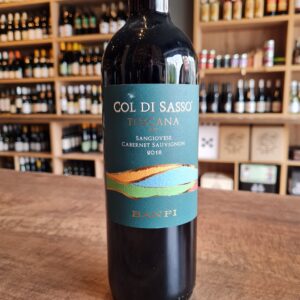 Col di Sasso meaning Stony Hill – the blend of Cabernet Sauvignon and Sangiovese cultivated on the most rocky and impervious slopes of the Banfi estate in Montalcino. A young, but intense wine. The color is ruby red with purple shades. The wine shows intense and fruity scents of black currant, cherry and other red fruits. The structure is soft and magnificently sustained by a good acidity, resulting from the sweet and mellow tannins. The finish is pleasant and with a balanced complexity.
Col di Sasso meaning Stony Hill – the blend of Cabernet Sauvignon and Sangiovese cultivated on the most rocky and impervious slopes of the Banfi estate in Montalcino. A young, but intense wine. The color is ruby red with purple shades. The wine shows intense and fruity scents of black currant, cherry and other red fruits. The structure is soft and magnificently sustained by a good acidity, resulting from the sweet and mellow tannins. The finish is pleasant and with a balanced complexity. -
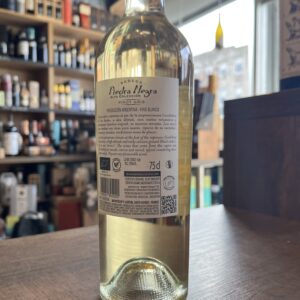
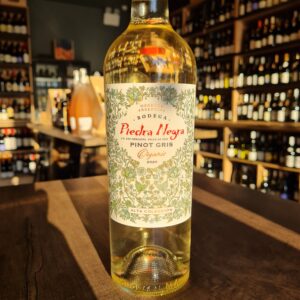 The Alta Colleción Pinot Gris from Bodega Piedra Negra can be considered an excellent ambassador of the unique Lurton wine style. A clear fruit, seductive grace and an unmistakable personality characterise this pure Pinot Gris.This wine fills the glass with a bright straw yellow with greenish reflections. The fragrant bouquet unfolds fresh fruity, aromatic notes of white peach and pear. The fresh, juicy taste brings lots of fruit and a lively acidity. Despite everything, this Argentine white wine is soft, full-bodied and wonderfully balanced, making it a racy and charming seducer. In the finish, the beautiful aroma lasts for a long time. This dry white wine from Argentina goes excellently with pasta with fish and seafood, monkfish with provencal herbs and spices or roasted pork.
The Alta Colleción Pinot Gris from Bodega Piedra Negra can be considered an excellent ambassador of the unique Lurton wine style. A clear fruit, seductive grace and an unmistakable personality characterise this pure Pinot Gris.This wine fills the glass with a bright straw yellow with greenish reflections. The fragrant bouquet unfolds fresh fruity, aromatic notes of white peach and pear. The fresh, juicy taste brings lots of fruit and a lively acidity. Despite everything, this Argentine white wine is soft, full-bodied and wonderfully balanced, making it a racy and charming seducer. In the finish, the beautiful aroma lasts for a long time. This dry white wine from Argentina goes excellently with pasta with fish and seafood, monkfish with provencal herbs and spices or roasted pork. -
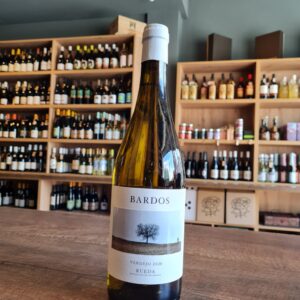 Bardos Verdejo is a wine made from 100% Verdejo from vineyards that are 20-25 years old, located in Rueda, at more than 700 metres of altitude on stony soils. The harvest is carried out at night, at temperatures below 15ºC. The fermentation is done with local yeasts at a controlled temperature and the wine rests on its lees for at least 4 months, gaining complexity and texture. On the nose, the intense aromas of fruit such as white peach combine with cut grass, citrus, balsamic and mineral notes. In the mouth it has a good volume and persistence, well integrated acidity and a characteristic aniseed aftertaste, typical of the grape. Really a high quality example of this native Spanish variety. Excellent with light bites, starters, salads and white fish. All of the wines by De Bardos are crafted by hand in a fully artisan manner.
Bardos Verdejo is a wine made from 100% Verdejo from vineyards that are 20-25 years old, located in Rueda, at more than 700 metres of altitude on stony soils. The harvest is carried out at night, at temperatures below 15ºC. The fermentation is done with local yeasts at a controlled temperature and the wine rests on its lees for at least 4 months, gaining complexity and texture. On the nose, the intense aromas of fruit such as white peach combine with cut grass, citrus, balsamic and mineral notes. In the mouth it has a good volume and persistence, well integrated acidity and a characteristic aniseed aftertaste, typical of the grape. Really a high quality example of this native Spanish variety. Excellent with light bites, starters, salads and white fish. All of the wines by De Bardos are crafted by hand in a fully artisan manner. -
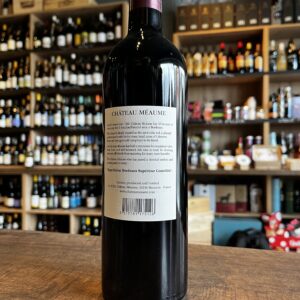
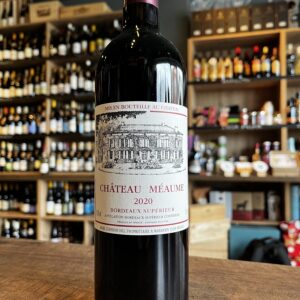 Most of us know Roald Dahl's novels, I for one have read them countless times. Firstly to my eldest and now, once in while I try with the middle one, even though he is still a bit young for those books. He is only 4 my wife says! They are just fun to read. To my surprise, after deciding to bring Château Méaume Bordeaux Supérieur to our Pinto Wines portfolio I came across that it was Roald Dahl's favourite wine and per his own words ''simply delicious''. Well I could not put it better myself. It is a fantastic wine, with superb quality at this price point and what some would call a ''Big little wine.'' Unpretentious especially being French and carries a lot with it. It has a warm, expressive black fruits with a serious, rustic, spicy structure. A hint of exotic perfume on the nose, with a luscious, very ripe blackberry and damson palate.80% merlot, with cabernets franc and sauvignon adding a rich, chewy texture. Very more-ish, with freshness, and great balance.Château Méaume, owned by English couple Alan and Sue Johnson-Hill since 1980, is an historic property just 10 miles from the famous vineyards of St-Emilion and Pomerol. The 2016 Vintage is one of the best produced after the 2000's and critics were fast to praise the 2018. Cheers Roald!
Most of us know Roald Dahl's novels, I for one have read them countless times. Firstly to my eldest and now, once in while I try with the middle one, even though he is still a bit young for those books. He is only 4 my wife says! They are just fun to read. To my surprise, after deciding to bring Château Méaume Bordeaux Supérieur to our Pinto Wines portfolio I came across that it was Roald Dahl's favourite wine and per his own words ''simply delicious''. Well I could not put it better myself. It is a fantastic wine, with superb quality at this price point and what some would call a ''Big little wine.'' Unpretentious especially being French and carries a lot with it. It has a warm, expressive black fruits with a serious, rustic, spicy structure. A hint of exotic perfume on the nose, with a luscious, very ripe blackberry and damson palate.80% merlot, with cabernets franc and sauvignon adding a rich, chewy texture. Very more-ish, with freshness, and great balance.Château Méaume, owned by English couple Alan and Sue Johnson-Hill since 1980, is an historic property just 10 miles from the famous vineyards of St-Emilion and Pomerol. The 2016 Vintage is one of the best produced after the 2000's and critics were fast to praise the 2018. Cheers Roald! -
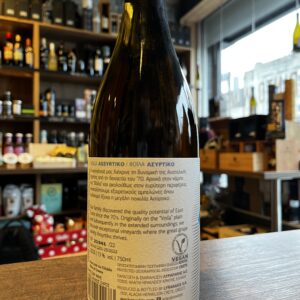
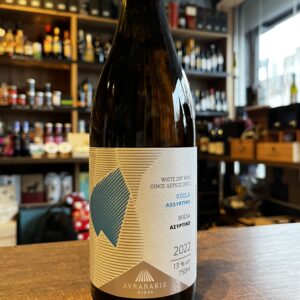 Anyone that has been to Greece or has interest in wines have come by the grape Assyrtiko . In the last few years, wines from Greece, in particularly this indigenous grape, have gotten the status as a world-class wine and prices have begun to rise especially from the Santorini region. This Vegan Assyrtiko from the Lyrarakis estate is one of them and it is still in the affordable range and fortunately, your everyday Assyrtiko needs can still be catered for. Being from east Crete rather than Santorini means prices are still competitive. Think down the lines of getting a wine from the Touraine region rather than the heart of the Loire Valley. Lyrarakis on Crete are a brilliant winery with a focus on indigenous Greek varieties. Their rendition of Assyrtiko is broader and more approachable than some of the tightly-wound examples on Santorini, but it's no less drinkable for that. It is in fact an ideal place to grow the white grape Assyrtiko. Both the Mediterranean breezes and the altitude of the Lyrarakis vineyards allows the grapes to have a much longer ripening period, preserving the grapes aromatics and acidity resulting in a wine with wonderful floral freshness, crisp citrus notes and a delicate mineral finish. Yamas!
Anyone that has been to Greece or has interest in wines have come by the grape Assyrtiko . In the last few years, wines from Greece, in particularly this indigenous grape, have gotten the status as a world-class wine and prices have begun to rise especially from the Santorini region. This Vegan Assyrtiko from the Lyrarakis estate is one of them and it is still in the affordable range and fortunately, your everyday Assyrtiko needs can still be catered for. Being from east Crete rather than Santorini means prices are still competitive. Think down the lines of getting a wine from the Touraine region rather than the heart of the Loire Valley. Lyrarakis on Crete are a brilliant winery with a focus on indigenous Greek varieties. Their rendition of Assyrtiko is broader and more approachable than some of the tightly-wound examples on Santorini, but it's no less drinkable for that. It is in fact an ideal place to grow the white grape Assyrtiko. Both the Mediterranean breezes and the altitude of the Lyrarakis vineyards allows the grapes to have a much longer ripening period, preserving the grapes aromatics and acidity resulting in a wine with wonderful floral freshness, crisp citrus notes and a delicate mineral finish. Yamas! -
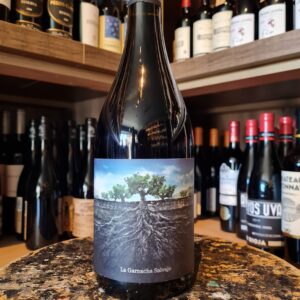 There's a lovely off the beaten track mountain wilderness (salvaje means wild) to this old-vine Garnacha (aka Grenache), one of six under the the creative Vintae's Proyecto Garnachas banner that showcase the grape variety from old vineyards in different areas of the Ebro Valley in northeast Spain. Like Gamay and Zinfandel, the old vines of Grenache are a timeless wonder. They are the Clint Eastwood of vitis vinifera: gnarled by age with a tough-as-nails exterior and no sign of retirement on the horizon. What they lack in quantity, they make up for in quality: grape clusters from old-vine Grenache (think 60-100 years old) can create wines of supple fruit, spicy character and rocket-fueled energy. This one is no exception, the Salvaje vineyards lie on rocky soils at 820m above sea level, on the north face of the Moncayo massif mountain chain, where Navarra and Aragón meet and the Atlantic influence brings mouthwatering freshness and clarity to the generous raspberry, wild herb and pepper flavours this wine induces. It doesn't need food, but it's very accommodating: spot on with roast peppers, aubergine, tomatoes and onions and with spicy sausages such as chorizo. It would be equally good with roast root vegetables, slow-roast lamb or pork, baked spiced duck legs or a ham joint and would make a good barbecue all-rounder.
There's a lovely off the beaten track mountain wilderness (salvaje means wild) to this old-vine Garnacha (aka Grenache), one of six under the the creative Vintae's Proyecto Garnachas banner that showcase the grape variety from old vineyards in different areas of the Ebro Valley in northeast Spain. Like Gamay and Zinfandel, the old vines of Grenache are a timeless wonder. They are the Clint Eastwood of vitis vinifera: gnarled by age with a tough-as-nails exterior and no sign of retirement on the horizon. What they lack in quantity, they make up for in quality: grape clusters from old-vine Grenache (think 60-100 years old) can create wines of supple fruit, spicy character and rocket-fueled energy. This one is no exception, the Salvaje vineyards lie on rocky soils at 820m above sea level, on the north face of the Moncayo massif mountain chain, where Navarra and Aragón meet and the Atlantic influence brings mouthwatering freshness and clarity to the generous raspberry, wild herb and pepper flavours this wine induces. It doesn't need food, but it's very accommodating: spot on with roast peppers, aubergine, tomatoes and onions and with spicy sausages such as chorizo. It would be equally good with roast root vegetables, slow-roast lamb or pork, baked spiced duck legs or a ham joint and would make a good barbecue all-rounder. -
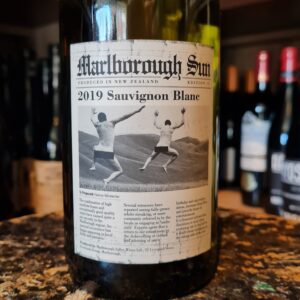 Fantastic New Zealand Sauvignon that will tick all the boxes. The extraordinary label of this wine and the bright recognizable taste have created a direct connection between the Marlborough Sun brand and consumers all over the world. With the growing popularity of Marlborough Valley wines, Saint Clair conceived the idea of creating an affordable, non-pompous wine aimed at attracting new consumers who are not fans of the drink. The progressive technologies of winemaking of the New World, the peculiarities of the terroir of the valley, the varieties that have proven themselves most successfully in the local microclimate and the human factor, have found their reflection in the wines of Marlborough Sun. The inspiration for the labels came from a newspaper article about an unusual phenomenon that has swept the region. It is recommended to serve chilled to a temperature of 8-10 degrees, as a supplement to vegetarian dishes, as well as salmon and tuna.
Fantastic New Zealand Sauvignon that will tick all the boxes. The extraordinary label of this wine and the bright recognizable taste have created a direct connection between the Marlborough Sun brand and consumers all over the world. With the growing popularity of Marlborough Valley wines, Saint Clair conceived the idea of creating an affordable, non-pompous wine aimed at attracting new consumers who are not fans of the drink. The progressive technologies of winemaking of the New World, the peculiarities of the terroir of the valley, the varieties that have proven themselves most successfully in the local microclimate and the human factor, have found their reflection in the wines of Marlborough Sun. The inspiration for the labels came from a newspaper article about an unusual phenomenon that has swept the region. It is recommended to serve chilled to a temperature of 8-10 degrees, as a supplement to vegetarian dishes, as well as salmon and tuna. -
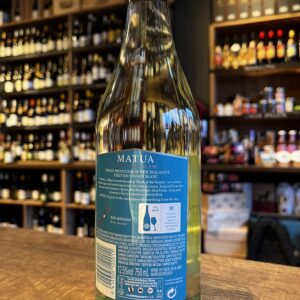
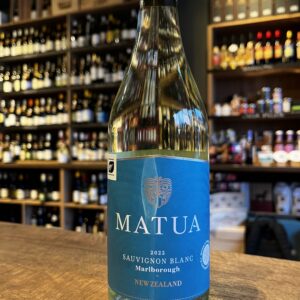 This wine represents the legend of Kupe tangling with a giant octopus who kept stealing all his fish off the hook. During the ensuing fight the beast's tentacles gouged out the Marlborough Sounds and Kupe cut out its eyes which he placed on two rocks known today as Nga Whatu ' The Eyes'. It’s hard to separate New Zealand and Sauvignon Blanc these days, but Matua were the first to put them together, over 40 years ago. You could say They've changed the way the world enjoys white wine. As the Head of the Family (the Maori translation of Matua) They have a tradition of telling stories as a way of passing on knowledge to the next generation. Their most famous winegrowing regions set the scene for some great legendary historical folklore. Wines match dishes from cooked salmon, lettuce, chicken and mushrooms.
This wine represents the legend of Kupe tangling with a giant octopus who kept stealing all his fish off the hook. During the ensuing fight the beast's tentacles gouged out the Marlborough Sounds and Kupe cut out its eyes which he placed on two rocks known today as Nga Whatu ' The Eyes'. It’s hard to separate New Zealand and Sauvignon Blanc these days, but Matua were the first to put them together, over 40 years ago. You could say They've changed the way the world enjoys white wine. As the Head of the Family (the Maori translation of Matua) They have a tradition of telling stories as a way of passing on knowledge to the next generation. Their most famous winegrowing regions set the scene for some great legendary historical folklore. Wines match dishes from cooked salmon, lettuce, chicken and mushrooms. -
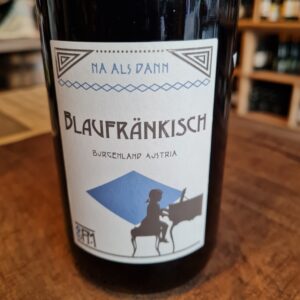 Blaufränkisch equals Austria. It is one of those typical, local, emerging grapes that have put Austria on the international wine market in recent years. Spicy nose with notes of ripe fruit such as currants and blackberries. The tannins are soft but present enough to structure the wine.All combines in a high-quality example of typical Blaufränkisch.
Blaufränkisch equals Austria. It is one of those typical, local, emerging grapes that have put Austria on the international wine market in recent years. Spicy nose with notes of ripe fruit such as currants and blackberries. The tannins are soft but present enough to structure the wine.All combines in a high-quality example of typical Blaufränkisch. -
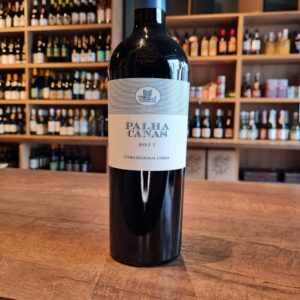 Aromatically very complex, it presents strong sensations of red fruits, jam and vanilla. Equally complex in the tasting, it evolutes to smooth velvety notes of red and ripe fruits, chocolate and oak ageing. Persistent and well-balanced aftertaste with tannins that evidence the structure of the wine and its longevity. Enjoy the Palha-Canas Tinto with hearty dishes from pork and beef, lamb and game. In addition, the wine goes perfectly with soft and hard cheese. You would have to stand on the terrace of the estate to understand why it is called Boavista (“fine view”). Your gaze would naturally wander over the vineyards which slope down into the valley in front of the house and then meet two hills on the opposite side where the lines of vines form an exciting geometrical pattern. It is a fine view indeed, this sight of the vineyards of Boavista. The Quinta de Boavista is situated right in the middle of the hills of the Estremadura wine-growing region, about fifty kilometres north of Lisbon. The close proximity of the nearby ocean provides for humidity and wind. The soil composition is a sandy clay. It is full of fossilized ocean deposits and right in front of the estate big petrified bones of a saurian were found which now adorn the terrace. The land has been owned for generations by the family of José Luis Oliveira da Silva. He is a banker by profession. For some years now he has focussed on wine-growing. He modernised the wine cellar, bought new barrels and recruited an able oenologist. He was among the first in Portugal who produced varietal wines from autochthonous grapes. The results are very exciting. The white Fernao Pires is a wine with attractive fruit aromas and with a distinct mineral note, the red Castelao and the red Tinta Roriz are wines that have concentration and a complex personality. This new generation of Portuguese wines gives you offhand inspiration.
Aromatically very complex, it presents strong sensations of red fruits, jam and vanilla. Equally complex in the tasting, it evolutes to smooth velvety notes of red and ripe fruits, chocolate and oak ageing. Persistent and well-balanced aftertaste with tannins that evidence the structure of the wine and its longevity. Enjoy the Palha-Canas Tinto with hearty dishes from pork and beef, lamb and game. In addition, the wine goes perfectly with soft and hard cheese. You would have to stand on the terrace of the estate to understand why it is called Boavista (“fine view”). Your gaze would naturally wander over the vineyards which slope down into the valley in front of the house and then meet two hills on the opposite side where the lines of vines form an exciting geometrical pattern. It is a fine view indeed, this sight of the vineyards of Boavista. The Quinta de Boavista is situated right in the middle of the hills of the Estremadura wine-growing region, about fifty kilometres north of Lisbon. The close proximity of the nearby ocean provides for humidity and wind. The soil composition is a sandy clay. It is full of fossilized ocean deposits and right in front of the estate big petrified bones of a saurian were found which now adorn the terrace. The land has been owned for generations by the family of José Luis Oliveira da Silva. He is a banker by profession. For some years now he has focussed on wine-growing. He modernised the wine cellar, bought new barrels and recruited an able oenologist. He was among the first in Portugal who produced varietal wines from autochthonous grapes. The results are very exciting. The white Fernao Pires is a wine with attractive fruit aromas and with a distinct mineral note, the red Castelao and the red Tinta Roriz are wines that have concentration and a complex personality. This new generation of Portuguese wines gives you offhand inspiration. -
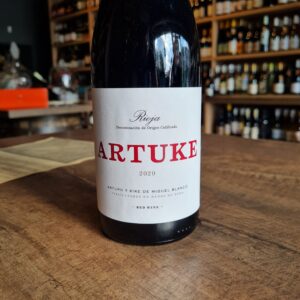 Made in a Beaujolais style, with the carbonic maceration method. This juicy ''Joven'' fresh fruited style of Rioja has zero oak influence as it ages in concrete tanks for 6 months. Farmed without any synthetic fertilizers or pesticides. Arturo Blanco was once asked what the philosophy at Bodegas Artuke was and he simply replied 'we are farmers'. The approach here is 100% focused on interpreting the family's 32 plots which are split between the villages of Baños de Ebro and Ábalos in Rioja Alavesa. Biodynamic techniques are employed in the vineyards and Arturo and Kike are also busy recovering old, ignored plots of ancient vines. Vinification is aimed at expressing the characteristics of the vineyard and quality of fruit above all else. The restrained use of oak and inclination towards different types/sizes of barrel, plus an unwillingness to adhere to the subscribed regimes for classification means that Artuke are precluded from using Crianza, Reserva and Gran Reserva designations on their wines. This mouth-watering red wine takes a relatively deep chill which makes it a versatile pairing with all types of food: tuna, pretty much anything made with zucchini, fried chicken, gooey cheese sandwiches, pizza, etc…
Made in a Beaujolais style, with the carbonic maceration method. This juicy ''Joven'' fresh fruited style of Rioja has zero oak influence as it ages in concrete tanks for 6 months. Farmed without any synthetic fertilizers or pesticides. Arturo Blanco was once asked what the philosophy at Bodegas Artuke was and he simply replied 'we are farmers'. The approach here is 100% focused on interpreting the family's 32 plots which are split between the villages of Baños de Ebro and Ábalos in Rioja Alavesa. Biodynamic techniques are employed in the vineyards and Arturo and Kike are also busy recovering old, ignored plots of ancient vines. Vinification is aimed at expressing the characteristics of the vineyard and quality of fruit above all else. The restrained use of oak and inclination towards different types/sizes of barrel, plus an unwillingness to adhere to the subscribed regimes for classification means that Artuke are precluded from using Crianza, Reserva and Gran Reserva designations on their wines. This mouth-watering red wine takes a relatively deep chill which makes it a versatile pairing with all types of food: tuna, pretty much anything made with zucchini, fried chicken, gooey cheese sandwiches, pizza, etc… -
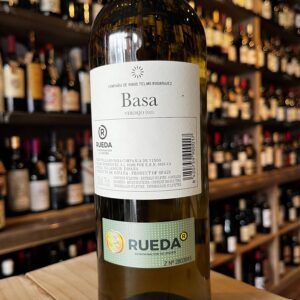
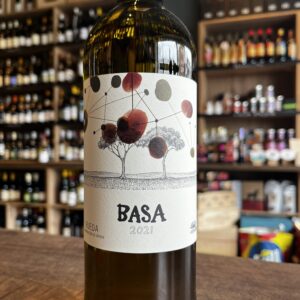 Telmo Rodriguez of Basque origin, studied wine at the Institute of Oenology in Bordeaux, before doing internships with Cos d’Estournel, Jean Louis Chave and Trevallon . He also worked in the vinification of wines from the family estate of Remelluri, in Rioja. Then, in 1990, with an investment of just a few thousand euros, he launched his own winery. He buys grapes to produce his first wines. His first plots of property did not arrive until 1997, in Rioja. Paradoxical for someone who was dying to explore new regions. One of the main principles of Telmo Rodriguez is that of respecting the Spanish tradition of cultivating the vine in goblet, because this method of managing the vine protects it from the great heat of Iberian vineyards. He is fiercely opposed to the fashion of trellising vineyards and only buys vines that respect his ideal. Telmo also works in biodynamics but, showing great common sense, he admits that he only does it for the respect of the land and that the mention of organic viticulture has no importance in his eyes. The important thing is that the result is a balanced and tasty wine. The name comes from the 40-year-old 'baso' or bush-trained vines that are planted on limestone-rich soils at over 700-meters elevation on a plateau along the Duero River. Soils are made of gravel from fluvial terraces, erosion slopes and glacis. Pairs great with comfort food, Tapas and Tortillas of all sorts
Telmo Rodriguez of Basque origin, studied wine at the Institute of Oenology in Bordeaux, before doing internships with Cos d’Estournel, Jean Louis Chave and Trevallon . He also worked in the vinification of wines from the family estate of Remelluri, in Rioja. Then, in 1990, with an investment of just a few thousand euros, he launched his own winery. He buys grapes to produce his first wines. His first plots of property did not arrive until 1997, in Rioja. Paradoxical for someone who was dying to explore new regions. One of the main principles of Telmo Rodriguez is that of respecting the Spanish tradition of cultivating the vine in goblet, because this method of managing the vine protects it from the great heat of Iberian vineyards. He is fiercely opposed to the fashion of trellising vineyards and only buys vines that respect his ideal. Telmo also works in biodynamics but, showing great common sense, he admits that he only does it for the respect of the land and that the mention of organic viticulture has no importance in his eyes. The important thing is that the result is a balanced and tasty wine. The name comes from the 40-year-old 'baso' or bush-trained vines that are planted on limestone-rich soils at over 700-meters elevation on a plateau along the Duero River. Soils are made of gravel from fluvial terraces, erosion slopes and glacis. Pairs great with comfort food, Tapas and Tortillas of all sorts -
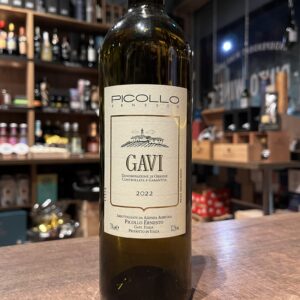 Picollo Gavi Ernesto is perched among the rolling hills that surround the town of Gavi. The climate here is much more mediterranean than in the north, benefiting from the constant maritime breezes, unique to the southern Piedmont. Picollo Ernesto’s vineyards sit near 260 meters above sea level in Rovereto di Gavi, one of the most prestigious area of the appellation. Our 16 hectares of vineyards are planted exclusively with Cortese, a hearty, high acid white varietal, perfectly suited for this area in northern Italy. Cortese thrives in difficult soil, dry climate, and full sun exposure, which Rovereto amply provides. Picollo’s vineyards are predominantly south-facing and the soils have a higher concentration of clay than marl, which allows for year-round water conservation, even in the peak of summer. Lorenzo Picollo founded the winery in 1945. The winemaking and day-to-day management was transferred to his son, Ernesto, and is now in the hands of his grandson, Gianlorenzo. Innovating along the way, Gianlorenzo continues to carry the family’s legacy forward with great success. Their lands are predominantly in the Rovereto zone, the historic Le Rive vineyards are over sixty years old instead their newest purchase of two hectares lies within the zone of Tassarolo. The grapes for all of Picollo’s wines are hand harvested. The winery itself has recently been modernized but the processes remain traditional, with sparing intervention in the winemaking and no artificial pesticides or herbicides used in the vineyards. With the intent of showcasing the Cortese in its purest form. All Gavi’s are fermented and aged exclusively in stainless steel. It is perfect with haute cuisine, ideal for fish dishes and aperitif
Picollo Gavi Ernesto is perched among the rolling hills that surround the town of Gavi. The climate here is much more mediterranean than in the north, benefiting from the constant maritime breezes, unique to the southern Piedmont. Picollo Ernesto’s vineyards sit near 260 meters above sea level in Rovereto di Gavi, one of the most prestigious area of the appellation. Our 16 hectares of vineyards are planted exclusively with Cortese, a hearty, high acid white varietal, perfectly suited for this area in northern Italy. Cortese thrives in difficult soil, dry climate, and full sun exposure, which Rovereto amply provides. Picollo’s vineyards are predominantly south-facing and the soils have a higher concentration of clay than marl, which allows for year-round water conservation, even in the peak of summer. Lorenzo Picollo founded the winery in 1945. The winemaking and day-to-day management was transferred to his son, Ernesto, and is now in the hands of his grandson, Gianlorenzo. Innovating along the way, Gianlorenzo continues to carry the family’s legacy forward with great success. Their lands are predominantly in the Rovereto zone, the historic Le Rive vineyards are over sixty years old instead their newest purchase of two hectares lies within the zone of Tassarolo. The grapes for all of Picollo’s wines are hand harvested. The winery itself has recently been modernized but the processes remain traditional, with sparing intervention in the winemaking and no artificial pesticides or herbicides used in the vineyards. With the intent of showcasing the Cortese in its purest form. All Gavi’s are fermented and aged exclusively in stainless steel. It is perfect with haute cuisine, ideal for fish dishes and aperitif -
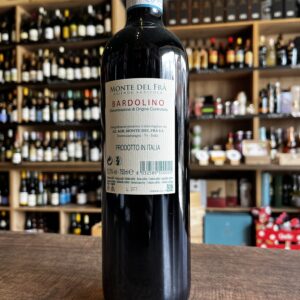
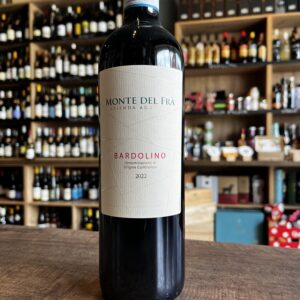 This wine is from the hills that are located in a Guyot at 100/150 meters above sea level, of morainic origin with calcareous, clayey, gravelly, sandy soil.From the municipality of Sommacampagna located southeast of Lake Garda.A well-balanced, fresh and easy-drinking style dry and rounded red wine. Delicately fruity and fragrant, with notes of cherries, strawberries, raspberries and red currants as well as hints of spices. Recommended with light snacks, cold cuts, light meals, tapas, pasta and fish in general (particularly freshwater fish).
This wine is from the hills that are located in a Guyot at 100/150 meters above sea level, of morainic origin with calcareous, clayey, gravelly, sandy soil.From the municipality of Sommacampagna located southeast of Lake Garda.A well-balanced, fresh and easy-drinking style dry and rounded red wine. Delicately fruity and fragrant, with notes of cherries, strawberries, raspberries and red currants as well as hints of spices. Recommended with light snacks, cold cuts, light meals, tapas, pasta and fish in general (particularly freshwater fish). -
Out of stock
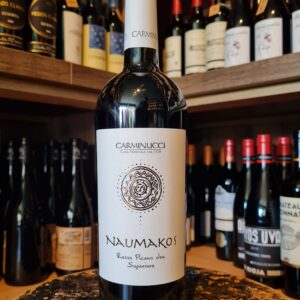 The Carminucci company, with its 90 years of history, is inserted in the wonderful wine landscape of the Marche, a region that gives powerful emotions thanks to its landscapes and a geographical conformation that allows it to have very particular climatic excursions. Kissed by the Adriatic and pampered by the hills, this region, rich in native vines and wine culture, offers a wine obtained from a blend rich in charm such as Rosso Piceno, which we tasted in its "superior" version. Montepulciano, combined with Sangiovese, ages in small and large barrels to bring to the table a product with marked minerality and softness, strength and structure, always sweetened by fresh notes that make it unique in its characteristics. The color is rich in anthocyanins, the light is unable to penetrate the richness of color of this red wine, but the first impact on the nose makes it less austere than you might imagine. Ample in its aromas of red fruit and slightly spicy in sweet notes, Carminucci's Rosso Piceno is a pleasant wine from the first sip for its authenticity and balance. If you leave it in your mouth for a moment, warm Mediterranean flavors emerge combined with a pleasant note of licorice, a balanced alcohol that has a strong but never invasive structure. Its harmony is given by the set of sensations and gustatory touches, a frank and very balanced wine, it combines the sapidity of the area with an acidity that leads it to be a long-lived wine with excellent resistance over time. Excellent with red meats or game.
The Carminucci company, with its 90 years of history, is inserted in the wonderful wine landscape of the Marche, a region that gives powerful emotions thanks to its landscapes and a geographical conformation that allows it to have very particular climatic excursions. Kissed by the Adriatic and pampered by the hills, this region, rich in native vines and wine culture, offers a wine obtained from a blend rich in charm such as Rosso Piceno, which we tasted in its "superior" version. Montepulciano, combined with Sangiovese, ages in small and large barrels to bring to the table a product with marked minerality and softness, strength and structure, always sweetened by fresh notes that make it unique in its characteristics. The color is rich in anthocyanins, the light is unable to penetrate the richness of color of this red wine, but the first impact on the nose makes it less austere than you might imagine. Ample in its aromas of red fruit and slightly spicy in sweet notes, Carminucci's Rosso Piceno is a pleasant wine from the first sip for its authenticity and balance. If you leave it in your mouth for a moment, warm Mediterranean flavors emerge combined with a pleasant note of licorice, a balanced alcohol that has a strong but never invasive structure. Its harmony is given by the set of sensations and gustatory touches, a frank and very balanced wine, it combines the sapidity of the area with an acidity that leads it to be a long-lived wine with excellent resistance over time. Excellent with red meats or game. -
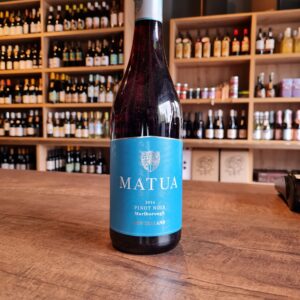 The name Matua, in New Zealand's native Maori language, means "head of the family," an appropriate title given this winery's instrumental role in developing Sauvignon Blanc into what is now New Zealand's most acknowledged wine varietal. You see there’s a couple of regions around the globe that planted Pinot Noir, that have really mastered it and New Zealands' Marlborough is indisputably one of those. It’s funny what a little perseverance does, and from their ragged tin shed in 1974, Bill and Ross Spence began to change the very foundation of wine in not just Marlborough, but New Zealand. They realized that Pinot Noir adapted exceptionally well to the well-drained alluvial soils of Marlborough and it’s unique climate. With the perfect amount of sunshine each day balanced out by cool evenings they struck Pinot Noir gold and have been developing a killer selection ever since. Matua have mastered the perfect balance of fruit-forward freshness with a touch of dry spice, a staple trait of the Marlborough Pinot Noir. You can expect generous aromas of freshly picked strawberries and red with a little ripe plum thrown into the mix. When taking a sip it’s the soft redcurrants, strawberries and cherries that jump out, brought together by a subtle spice, light tobacco and soothing dry earth. A touch of oak gives just enough complexity to enhance the flavors of this incredible wine. Highly Recommended
The name Matua, in New Zealand's native Maori language, means "head of the family," an appropriate title given this winery's instrumental role in developing Sauvignon Blanc into what is now New Zealand's most acknowledged wine varietal. You see there’s a couple of regions around the globe that planted Pinot Noir, that have really mastered it and New Zealands' Marlborough is indisputably one of those. It’s funny what a little perseverance does, and from their ragged tin shed in 1974, Bill and Ross Spence began to change the very foundation of wine in not just Marlborough, but New Zealand. They realized that Pinot Noir adapted exceptionally well to the well-drained alluvial soils of Marlborough and it’s unique climate. With the perfect amount of sunshine each day balanced out by cool evenings they struck Pinot Noir gold and have been developing a killer selection ever since. Matua have mastered the perfect balance of fruit-forward freshness with a touch of dry spice, a staple trait of the Marlborough Pinot Noir. You can expect generous aromas of freshly picked strawberries and red with a little ripe plum thrown into the mix. When taking a sip it’s the soft redcurrants, strawberries and cherries that jump out, brought together by a subtle spice, light tobacco and soothing dry earth. A touch of oak gives just enough complexity to enhance the flavors of this incredible wine. Highly Recommended -
Out of stock
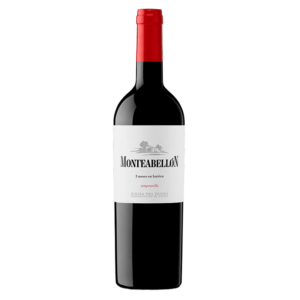 This attractive wine has its origin in the coolest vineyards located near the Douro River. The soil is sandy-loam with a slight gravel content. This gives it a very characteristic freshness that, combined with its aging in the barrel for 5 months (50% French and 50% American), gives rise to a wine with great personality and marked fruity nuances. Intense, bright cherry color. Very intense aroma with marked fruity sensations of blackberry and blueberries perfectly integrated with a quality wood that surrounds everything. Good structure and good fruity expression on the palate, powerful and with ripe tannins. An Oak from Ribera del Duero that you cannot miss.
This attractive wine has its origin in the coolest vineyards located near the Douro River. The soil is sandy-loam with a slight gravel content. This gives it a very characteristic freshness that, combined with its aging in the barrel for 5 months (50% French and 50% American), gives rise to a wine with great personality and marked fruity nuances. Intense, bright cherry color. Very intense aroma with marked fruity sensations of blackberry and blueberries perfectly integrated with a quality wood that surrounds everything. Good structure and good fruity expression on the palate, powerful and with ripe tannins. An Oak from Ribera del Duero that you cannot miss. -
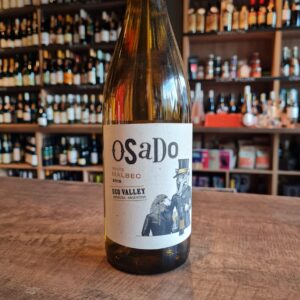 Being Osado or daring, is not being fearless, or not having second thoughts. Being Osado means living without prejudice, being free of any obligations and building your own way of life. Malbec brings a strong posture to this white wine and its aftertaste is long, fresh and clean. The grapes are harvested by hand in the cool of the morning, pressed under very low pressure so that no color has come off the grapes. The wine has been cold-consumed for 15 days and then matured in steel tanks on top of the precipitate for five months. This delicious wine is a very versatile food wine accompanied by grilled fish or asparagus, for example, and is also suitable as an aperitif as such. Grapes: Malbec 100%.
Being Osado or daring, is not being fearless, or not having second thoughts. Being Osado means living without prejudice, being free of any obligations and building your own way of life. Malbec brings a strong posture to this white wine and its aftertaste is long, fresh and clean. The grapes are harvested by hand in the cool of the morning, pressed under very low pressure so that no color has come off the grapes. The wine has been cold-consumed for 15 days and then matured in steel tanks on top of the precipitate for five months. This delicious wine is a very versatile food wine accompanied by grilled fish or asparagus, for example, and is also suitable as an aperitif as such. Grapes: Malbec 100%. -
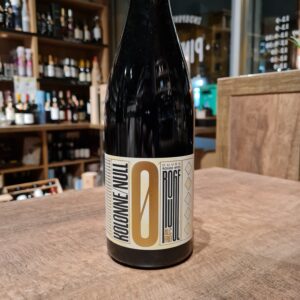 In the middle of the Spanish plateau "Meseta de Ocana" not far from Toledo, three friends founded their own winery in 1999: Margarita Madrigal, Alexandra Schmedes and Gonzalo Rodriguez. The revival of regional traditions became the basis of their way of working, which is characterized by the ecological cultivation of 35 hectares of native grape varieties and the extremely continental climate. Together with Alexandra, the first Spanish red wine, Cuvée Rouge No.2, was developed. This velvety, grippy taste makes it a must-drink on a barbecue evening, with risotto and pasta. The perfect non-alcoholic red wine for all those who love it wild and unbridled. Bring your Spain vacation home!
In the middle of the Spanish plateau "Meseta de Ocana" not far from Toledo, three friends founded their own winery in 1999: Margarita Madrigal, Alexandra Schmedes and Gonzalo Rodriguez. The revival of regional traditions became the basis of their way of working, which is characterized by the ecological cultivation of 35 hectares of native grape varieties and the extremely continental climate. Together with Alexandra, the first Spanish red wine, Cuvée Rouge No.2, was developed. This velvety, grippy taste makes it a must-drink on a barbecue evening, with risotto and pasta. The perfect non-alcoholic red wine for all those who love it wild and unbridled. Bring your Spain vacation home! -
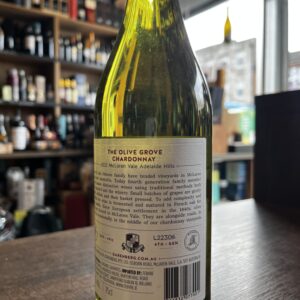
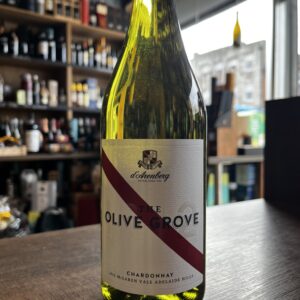 Since 1912 the Osborn family have tended vineyardsin Mclaren Vale, South of Australia. Today fourth generation family member Chester(absolutely bonkers of a guy, draws a room in and within 2 minutes has your attention), makes distintive wines using traditional methods both in the vineyards and the winery. The name comes from European settlements that arised in the 1840’s, and with them olive trees have thrived in McLaren Vale. They are alongside roads, in gardens and occasionally, block their harvesters from doing a fully mechanical job! Perfect with Antipasti, asparagus, chicken and fish
Since 1912 the Osborn family have tended vineyardsin Mclaren Vale, South of Australia. Today fourth generation family member Chester(absolutely bonkers of a guy, draws a room in and within 2 minutes has your attention), makes distintive wines using traditional methods both in the vineyards and the winery. The name comes from European settlements that arised in the 1840’s, and with them olive trees have thrived in McLaren Vale. They are alongside roads, in gardens and occasionally, block their harvesters from doing a fully mechanical job! Perfect with Antipasti, asparagus, chicken and fish -
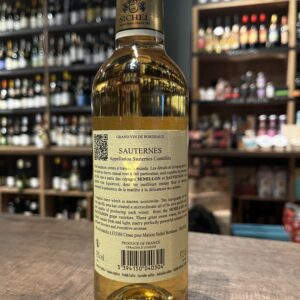
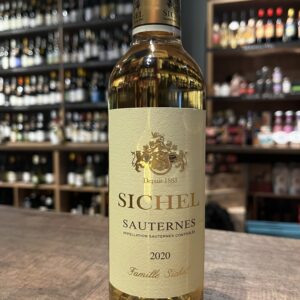 This is a declassified wine from a top Chateau in Sauternes...shhh, they dont want you to know their name! or...just keep reading Maison Sichel is a Bordeaux based, family owned and run negociant of six generations. The Sichel family have been a sugnificant prescence in Bordeaux since 1883 and have continued to expand operations by purchasing several properties in Bordeaux including Chateau Angludet and Chateau Argaden. The Sichel family also joined with three other family in 1938 to purchase the now legendary Chateau Palmer. Maison Sichel continued to expand their operations outside of Bordeaux with Chateau Trillol in Corbieres and have several high quality own label wines such as the Sichel Sauternes and the Sichel Margaux. The Sichekl Vineyards are situated some 40 kilometers south east of Bordeaux, between the Garonne river and the Landes forest to the south. A blend of 80% Semillon, 15% Sauvignon Blanc and 5% Muscadelle from 50 year old vines where Botrytis is encouraged to dehydrate the grapes. This Sauterne has been aged for 10 to 12 months.
This is a declassified wine from a top Chateau in Sauternes...shhh, they dont want you to know their name! or...just keep reading Maison Sichel is a Bordeaux based, family owned and run negociant of six generations. The Sichel family have been a sugnificant prescence in Bordeaux since 1883 and have continued to expand operations by purchasing several properties in Bordeaux including Chateau Angludet and Chateau Argaden. The Sichel family also joined with three other family in 1938 to purchase the now legendary Chateau Palmer. Maison Sichel continued to expand their operations outside of Bordeaux with Chateau Trillol in Corbieres and have several high quality own label wines such as the Sichel Sauternes and the Sichel Margaux. The Sichekl Vineyards are situated some 40 kilometers south east of Bordeaux, between the Garonne river and the Landes forest to the south. A blend of 80% Semillon, 15% Sauvignon Blanc and 5% Muscadelle from 50 year old vines where Botrytis is encouraged to dehydrate the grapes. This Sauterne has been aged for 10 to 12 months. -
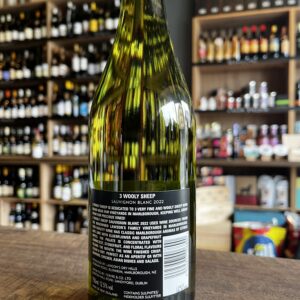
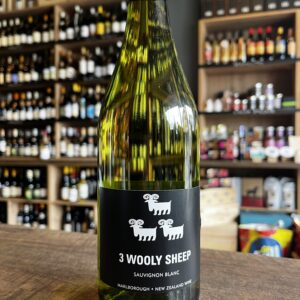 This quality wine has classic Marlborough aromas of citrus and limes with elderflower and grapefruit notes. The palate is concentrated with lemon zest, stonefruit and floral flavours filling the mouth. The wine finishes crisp, clean and dry. Perfect as an aperitif or with seafood, chicken, Asian dishes and salads.
This quality wine has classic Marlborough aromas of citrus and limes with elderflower and grapefruit notes. The palate is concentrated with lemon zest, stonefruit and floral flavours filling the mouth. The wine finishes crisp, clean and dry. Perfect as an aperitif or with seafood, chicken, Asian dishes and salads. -
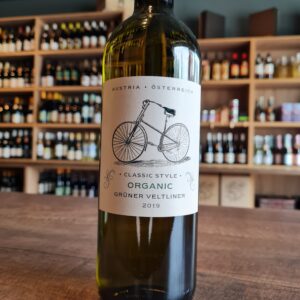 All Sepp Moser wines have been organic (and all estate wines biodynamic) since 2007. The Sepp Moser Estate comprises of 50 acres of vineyards in two prominent wine regions; Kremstal and Neusiedlersee. Now run by Sepp's son Nikolaus, he produces an international range of varieties as well as the ever more important local varieties of Gruner Veltliner and Riesling in the Kremstal. Delicate aromas of pear, kiwi, apricot and white spice. On the palate stone fruit flavours and white pepper lead to a gently textured, mineral and citrus finish. Great with fish, Chicken or light dishes in general. Lovely on its own on hot summer day
All Sepp Moser wines have been organic (and all estate wines biodynamic) since 2007. The Sepp Moser Estate comprises of 50 acres of vineyards in two prominent wine regions; Kremstal and Neusiedlersee. Now run by Sepp's son Nikolaus, he produces an international range of varieties as well as the ever more important local varieties of Gruner Veltliner and Riesling in the Kremstal. Delicate aromas of pear, kiwi, apricot and white spice. On the palate stone fruit flavours and white pepper lead to a gently textured, mineral and citrus finish. Great with fish, Chicken or light dishes in general. Lovely on its own on hot summer day -
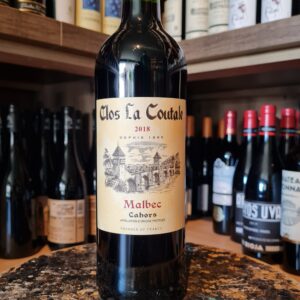 Malbec is the main grape in the legendary ‘Black wine of Cahors’. Way before Argentina made the varietal ‘famous’, Malbec – though in this region it is known as Côt or Auxerrois. – was making long-lived wines from Cahors – the 1959 Clos La Coutale is still drinking superbly. Clos La Coutale is a benchmark of the Cahors region and has a history of producing some of the finest and longest-lived wines of the region. Blackcurrants, blackberry's and prune notes followed by a soft and elegant palate that has an enticing note of vanilla. This Clos La Coutale wine is matured in barrels and wooden casks for one year in order to obtain a good balance between tannins and fruit. Organic and true gem at this price point.
Malbec is the main grape in the legendary ‘Black wine of Cahors’. Way before Argentina made the varietal ‘famous’, Malbec – though in this region it is known as Côt or Auxerrois. – was making long-lived wines from Cahors – the 1959 Clos La Coutale is still drinking superbly. Clos La Coutale is a benchmark of the Cahors region and has a history of producing some of the finest and longest-lived wines of the region. Blackcurrants, blackberry's and prune notes followed by a soft and elegant palate that has an enticing note of vanilla. This Clos La Coutale wine is matured in barrels and wooden casks for one year in order to obtain a good balance between tannins and fruit. Organic and true gem at this price point. -
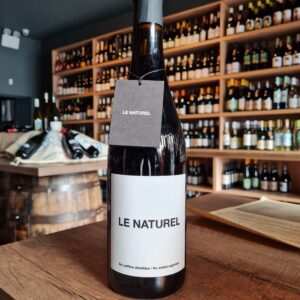 Le Naturel lives up to its name, it is a wine in which the Garnacha is expressed with great openness. On the nose aromas of blackberries and violets appear, while in the mouth it has a good attack of fresh fruit, typical of high altitude vineyards.It is a natural wine, without added sulfites, which also has the certificate of organic and vegan wine. With the aim of minimal intervention (in the field and in the winery) we found in Bodegas Aroa - Le Naturel a specimen of pure and enjoyable Grenache. Specially designed for consumption soon it is open and not for storage. Bodegas Aroa (Vintae group) is located in Zurucuáin, in the heart of the Yerri Valley , sheltered by the Urbasa and Andía Sierras. This winery is one of the pioneers in Navarra in its commitment to the recovery of organic farming practices .
Le Naturel lives up to its name, it is a wine in which the Garnacha is expressed with great openness. On the nose aromas of blackberries and violets appear, while in the mouth it has a good attack of fresh fruit, typical of high altitude vineyards.It is a natural wine, without added sulfites, which also has the certificate of organic and vegan wine. With the aim of minimal intervention (in the field and in the winery) we found in Bodegas Aroa - Le Naturel a specimen of pure and enjoyable Grenache. Specially designed for consumption soon it is open and not for storage. Bodegas Aroa (Vintae group) is located in Zurucuáin, in the heart of the Yerri Valley , sheltered by the Urbasa and Andía Sierras. This winery is one of the pioneers in Navarra in its commitment to the recovery of organic farming practices . -
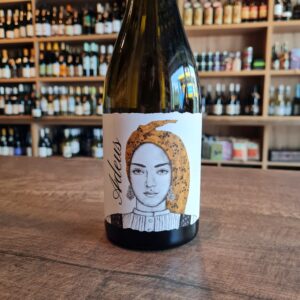 Adeus is the same in Galician as it is Portuguese and means ''Goodbye''. It is also the title of a Galician poem done by one of the most famous poets of Galicia, Rosalia de Castro. One worth that stays in between the love for her land and a homage to a woman that means so much for the history of Galicia. The Ribeiro is 45 km inland from the Atlantic Ocean and is situated in the middle of Valleys that protects it from the Atlantic winds. With 3 Rivers crossing has excellent conditions to produce wine. An excellent pair to grilled octopus with white asparagus garnish, monkfish fillet with stewed spinach and shrimps in garlic sauce
Adeus is the same in Galician as it is Portuguese and means ''Goodbye''. It is also the title of a Galician poem done by one of the most famous poets of Galicia, Rosalia de Castro. One worth that stays in between the love for her land and a homage to a woman that means so much for the history of Galicia. The Ribeiro is 45 km inland from the Atlantic Ocean and is situated in the middle of Valleys that protects it from the Atlantic winds. With 3 Rivers crossing has excellent conditions to produce wine. An excellent pair to grilled octopus with white asparagus garnish, monkfish fillet with stewed spinach and shrimps in garlic sauce -
Out of stock
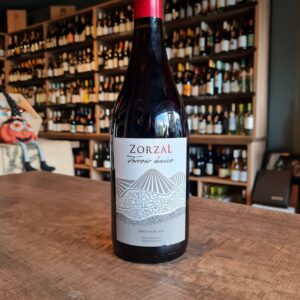
Founded in 2008 to promote the un-explored wine region of Gualtallary. The project is benefitting from investment in the best equipment and team possible. This new project is based on traditional winemaking, with medium scale production. Juan Pablo Michelini is responsible for the core of the concept, which revolves around majority of work being done in the vineyards. This combined with minimal intervention winemaking, best reflects the Gualtallary terroir.
Gualtallary is a remote place in the pre Andes, located in the Tupungato Department in the Northernmost sector of the Uco Valley in Mendoza. It is the highest altitude zone in the region, 1,200 to 1,600m above the sea level.
It has alluvial, primarily sandy soils with calcareous deposit and sectors with a presence of smooth round granitic riverbed stones, covered by calcium carbonate. The vineyard where this variety is grown is situated 1300 metres above sea level. It is a young vineyard, planted on chalky soils, with a very pronounced slope. This helps to keep the ground healthy, because there is no accumulation of water or frosts. The climate is mountainous, so we have a very wide temperature range, resulting in grapes with thicker skins considering it is a Pinot Noir.
The wines have lively, slightly austere profile, reflecting the soils and the altitude of the area. This hand harvested, single vineyard from Gualtallary is 100% Pinot Noir and is completely un-oaked to let the fruit driven quality of the wine shine. Great with and without food
-
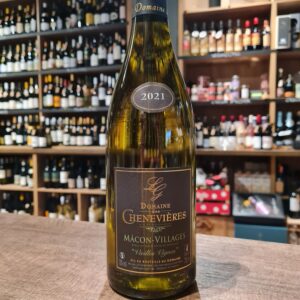 The Domaine des Chenevières has been in operation for 6 generations of winegrowers who love their land. The family farm is now managed by Sylvain, Benoît and Aurélien LENOIR, three cousins who succeeded their parents and took over the torch. The Domaine des Chenevières is located in the town of Saint-Maurice-de-Satonnay (71 Saône-et-Loire, Burgundy), a small village located halfway between Mâcon and Cluny. The vineyard with 46 hectares of vines is located in 3 municipalities: Saint-Maurice-de-Satonnay, Péronne and Azé, also renowned for its prehistoric caves. From pruning to harvesting, from vinification to bottling, everything is done with respect for tradition in order to bring you the enchantment of the aromas that will awaken your taste buds when tasting the white wines or the red wines from the production of the Domaine des Chenevières. The estate's vines are planted on hillsides and mid-hillsides, on clay-limestone soil. They are exposed South / South-East. The vines of the estate are between 20 and 60 years old and sustainable farming is part of every thought process. Thus, part of the vines remains grassed to promote biodiversity with an emphasis on tillage. They have a certification of HVE or High Environmental Value in all of their 46 hectares. Pair it with hors d'ouvres, grilled fish, shellfish, oysters, quiches, gratins. Great value Mâcon-Villages. Enjoy!
The Domaine des Chenevières has been in operation for 6 generations of winegrowers who love their land. The family farm is now managed by Sylvain, Benoît and Aurélien LENOIR, three cousins who succeeded their parents and took over the torch. The Domaine des Chenevières is located in the town of Saint-Maurice-de-Satonnay (71 Saône-et-Loire, Burgundy), a small village located halfway between Mâcon and Cluny. The vineyard with 46 hectares of vines is located in 3 municipalities: Saint-Maurice-de-Satonnay, Péronne and Azé, also renowned for its prehistoric caves. From pruning to harvesting, from vinification to bottling, everything is done with respect for tradition in order to bring you the enchantment of the aromas that will awaken your taste buds when tasting the white wines or the red wines from the production of the Domaine des Chenevières. The estate's vines are planted on hillsides and mid-hillsides, on clay-limestone soil. They are exposed South / South-East. The vines of the estate are between 20 and 60 years old and sustainable farming is part of every thought process. Thus, part of the vines remains grassed to promote biodiversity with an emphasis on tillage. They have a certification of HVE or High Environmental Value in all of their 46 hectares. Pair it with hors d'ouvres, grilled fish, shellfish, oysters, quiches, gratins. Great value Mâcon-Villages. Enjoy! -
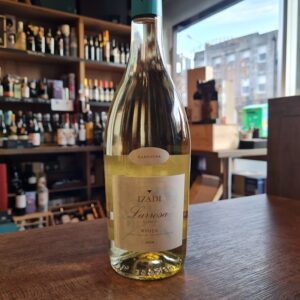 In 1987, Gonzalo Antón, in conjunction with a group of friends and business associates from Vitoria, decided to set up an innovative project in the heart of the Rioja Alavesa. Thus Bodegas Izadi came into being, situated in the triangle formed by the towns of Villabuena, Samaniego and Ábalos, the triangular motif on its labels, and with the clear objective of giving maximum expression to the fruit of that particular location, that natural environment so well-loved (Izadi means 'nature' in Basque), integrating innovation and tradition. This particular vineyard is situated 800m above sea level where the vines are planted in a mix of calcareous and clay soils. Izadi is also one of the few wineries truly involved with gastronomy, aware that even though there's a wine for every moment, on 90% of occasions it's served and enjoyed accompanied by food; and so that's why Izadi offers a wide variety of wines, all of which are very versatile. It's slogan leaves us in no doubt: "Wine and gastronomy are our passion". Since 2001, Lalo Antón has been heading up and managing the winery, and responsible for having driven forward business beyond local boundaries, as well as having started a programme of expansion with the successful Artevino group. Great with chicken, salads and oily fishes
In 1987, Gonzalo Antón, in conjunction with a group of friends and business associates from Vitoria, decided to set up an innovative project in the heart of the Rioja Alavesa. Thus Bodegas Izadi came into being, situated in the triangle formed by the towns of Villabuena, Samaniego and Ábalos, the triangular motif on its labels, and with the clear objective of giving maximum expression to the fruit of that particular location, that natural environment so well-loved (Izadi means 'nature' in Basque), integrating innovation and tradition. This particular vineyard is situated 800m above sea level where the vines are planted in a mix of calcareous and clay soils. Izadi is also one of the few wineries truly involved with gastronomy, aware that even though there's a wine for every moment, on 90% of occasions it's served and enjoyed accompanied by food; and so that's why Izadi offers a wide variety of wines, all of which are very versatile. It's slogan leaves us in no doubt: "Wine and gastronomy are our passion". Since 2001, Lalo Antón has been heading up and managing the winery, and responsible for having driven forward business beyond local boundaries, as well as having started a programme of expansion with the successful Artevino group. Great with chicken, salads and oily fishes -
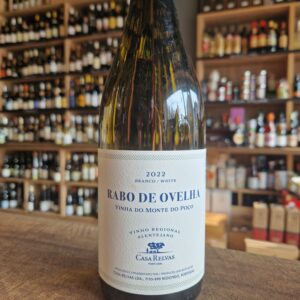 Casa Relvas is a family project, started in 1997 in São Miguel de Machede, in Redondo, by Alexandre Relvas, which aims to continue the history of five generations with a strong passion for the Alentejo and its genuine nature. Over the years, the family has grown along with the business and it didn't take long for it to total about 750 hectares of Montado forest, 225 hectares of olive groves, and 350 hectares of 100% integrated production vineyards. With the three estates - Herdade de São Miguel, Herdade da Pimenta and Herdade de São Miguel de Machede - Casa Relvas has the capacity to produce 6 million bottles of wine annually, 70% of which is to meet the needs of the foreign market, being present in over 30 countries worldwide, offering the best of the Alentejo.
Casa Relvas is a family project, started in 1997 in São Miguel de Machede, in Redondo, by Alexandre Relvas, which aims to continue the history of five generations with a strong passion for the Alentejo and its genuine nature. Over the years, the family has grown along with the business and it didn't take long for it to total about 750 hectares of Montado forest, 225 hectares of olive groves, and 350 hectares of 100% integrated production vineyards. With the three estates - Herdade de São Miguel, Herdade da Pimenta and Herdade de São Miguel de Machede - Casa Relvas has the capacity to produce 6 million bottles of wine annually, 70% of which is to meet the needs of the foreign market, being present in over 30 countries worldwide, offering the best of the Alentejo. -
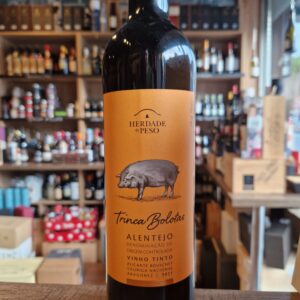 Moving freely through the cork oak forests of the Alentejo, where it feeds on acorns among other things, the Alentejo pig, a species indigenous to Portugal, is Europe's only surviving pastoral pig. Due to the way in which it forms part of the landscape and preserves the region's Mediterranean forest, it is part of Alentejo's heritage. Named after this reputable pig, this wine combines two of Alentejo's biggest symbols. All the grapes used in this wine were produced in accordance with the Sustainable Agriculture Integrated Production guidelines as defined by the International Organisation for Biological and Integrated Control (OILB/IOBC): www.iobc-wprs.org. The rigorous compliance with these practices is certified by an independent organisation, recognized by the Portuguese State. With its smooth tannins and enormous balance, this wine pairs wonderfully with light dishes, such as poultry and pasta, as well as with sausages, ham and more sophisticated meat dishes.
Moving freely through the cork oak forests of the Alentejo, where it feeds on acorns among other things, the Alentejo pig, a species indigenous to Portugal, is Europe's only surviving pastoral pig. Due to the way in which it forms part of the landscape and preserves the region's Mediterranean forest, it is part of Alentejo's heritage. Named after this reputable pig, this wine combines two of Alentejo's biggest symbols. All the grapes used in this wine were produced in accordance with the Sustainable Agriculture Integrated Production guidelines as defined by the International Organisation for Biological and Integrated Control (OILB/IOBC): www.iobc-wprs.org. The rigorous compliance with these practices is certified by an independent organisation, recognized by the Portuguese State. With its smooth tannins and enormous balance, this wine pairs wonderfully with light dishes, such as poultry and pasta, as well as with sausages, ham and more sophisticated meat dishes.


